vue教程
提示:Vue2系列请参考Vue2+Vue3小白零基础教程—vue3篇文章,本文为vue2篇。
1. Vue核心
1.1 Vue简介
1.1.1 Vue是什么
一套用于构建用户界面的渐进式JavaScript框架
渐进式:Vue可以自底向上逐层的应用
- 简单应用:只需一个轻量小巧的核心库
- 复杂应用:可以引入各式各样的Vue插件
1.1.2 谁开发的
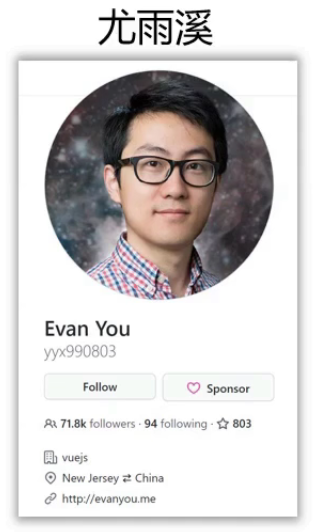
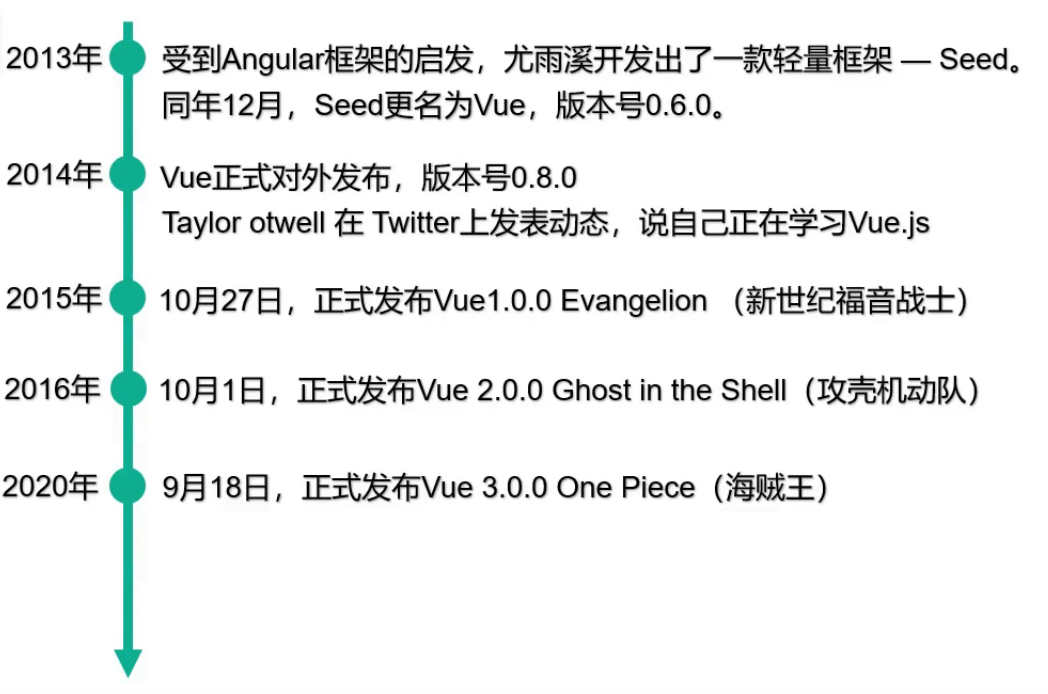
1.1.3 Vue的特点
采用组件化模式,提高代码复用率、且让代码更好维护。
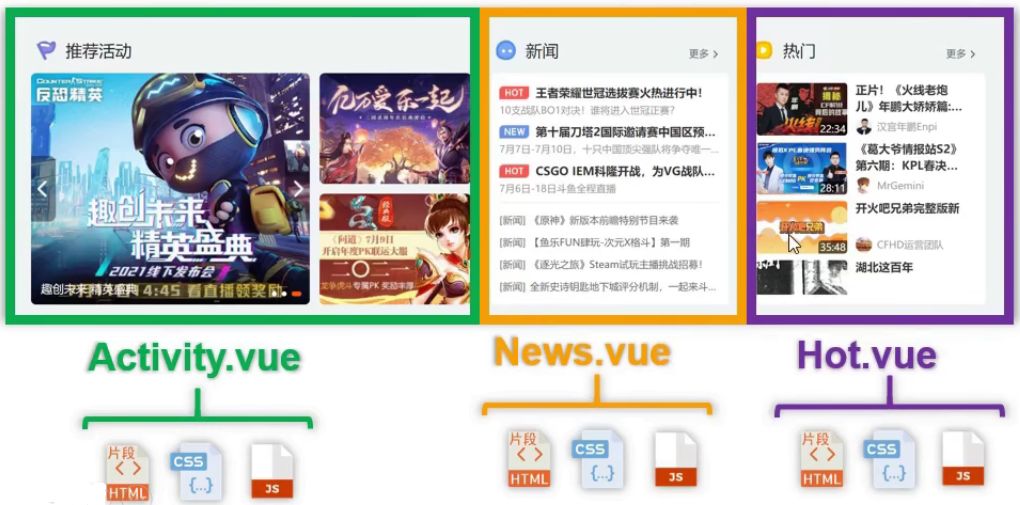
声明式编码,让编码人员无需直接操作DOM,提高开发效率。

使用虚拟DOM+优秀的Diff算法,尽量复用DOM节点
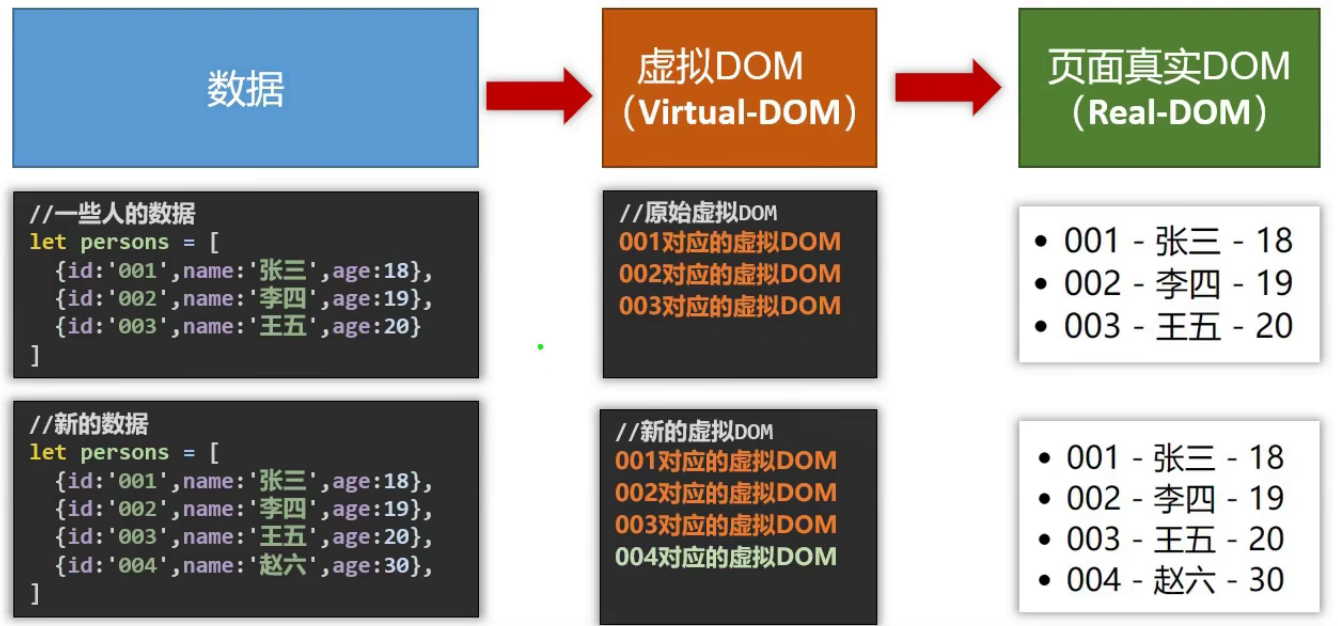
1.2 Vue快速体验
1.2.1 准备工作
-
下载Vue.js的chrome插件
? 下载地址:Vue Devtools
-
修改全局配置
<script type="text/javascript"> Vue.config.productionTip=false //以阻止 vue 在启动时生成生产提示 </script>
1.2.2 案例
<!DOCTYPE html>
<html lang="en">
<head>
<meta charset="UTF-8">
<meta http-equiv="X-UA-Compatible" content="IE=edge">
<meta name="viewport" content="width=device-width, initial-scale=1.0">
<title>demo-o1</title>
<script type="text/javascript" src="../js/vue.js" ></script>
</head>
<body>
<div id="box">
hello, {{name}}!
</div>
<script type="text/javascript">
Vue.config.productionTip=false //以阻止 vue 在启动时生成生产提示
const x = new Vue({
el:"#box", //用于指定当前Vue实例为哪个容器服务,通常使用css选择器
data:{ //data中的数据用于存储数据,数据供el所指定的容器使用
name:"张三"
}
})
</script>
</body>
</html>
1.2.3 总结
- 想让Vue工作,就必须创建一个Vue实例,且要传入一个配置对象;
- box容器里的代码依然符合html规范,只不过混入了一些特殊的Vue语法;
- box容器里的代码被称为【Vue模板】;
- Vue实例和容器是一 一对应的;
- 真实开发中只有一个Vue实例,并且会配合着组件一起使用;
- {{xxx}}中的xxx要写js表达式,且xxx可以自动读取到data中的所有属性;
- 一且data中的数据发生改变,那么页面中用到该数据的地方也会自动更新;
- 注意区分:js表达式和js代码(语句)
- 表达式:一个表达式会产生一个值,可以放在任何一个需要值的地方:
- a
- a+b
- demo(1)
- x===y?‘a’:‘b’
- js代码(语句)
- if(){}
- for(){}
- 表达式:一个表达式会产生一个值,可以放在任何一个需要值的地方:
- 注意区分:js表达式和js代码(语句)
1.3 Vue模板
Vue模板语法有2大类:
- 插值语法:
- 功能:用于解析标签体内容。
- 写法:[{xxx}],xxx是js表达式,且可以直接读取到data中的所有属性。
- 指令语法:
- 功能:用于解析标签(包括:标签属性、标签体内容、绑定事件…)。
- 举例:v-bind:href="xxx"或简写为:href=“xxx”,xxx同样要写js表达式,且可以直接读取到data中的所有属性。
- 备注:Vue中有很多的指令,且形式都是:V-???,此处我们只是拿v-bind举个例子。
<!DOCTYPE html>
<html lang="en">
<head>
<meta charset="UTF-8">
<meta http-equiv="X-UA-Compatible" content="IE=edge">
<meta name="viewport" content="width=device-width, initial-scale=1.0">
<title>Vue模板</title>
<script src="../js/vue.js" type="text/javascript"></script>
</head>
<body>
<div id="box">
<h1>插值语法</h1>
<p>你好,{{name}}</p>
<hr>
<h2>指令语法</h2>
<p>
<a :href="url">百度搜索</a>
</p>
</div>
</body>
<script type="text/javascript">
const x = new Vue({
el:"#box",
data:{
name:"Vue",
url:"https://www.baidu.com"
}
})
</script>
</html>
1.4 数据绑定
Vue中有2种数据绑定的方式:
-
单向绑定(v-bind):数据只能从data流向页面。
-
双向绑定(v-model):数据不仅能从data流向页面,还可以从页面流向data。
备注:
-
双向绑定一般都应用在表单类元素上(如:input、select等)
-
V-model:value可以简写为v-model,因为v-mode1默认收集的就是value值。
<!DOCTYPE html>
<html lang="en">
<head>
<meta charset="UTF-8">
<meta http-equiv="X-UA-Compatible" content="IE=edge">
<meta name="viewport" content="width=device-width, initial-scale=1.0">
<title>数据绑定</title>
<script src="../js/vue.js" type="text/javascript"></script>
</head>
<body>
<div id="box">
单向数据绑定:<input type="text" v-model:value="info1">
双向数据绑定:<input type="text" v-model:value="info2">
</div>
<script type="text/javascript">
Vue.config.productionTip=false //以阻止 vue 在启动时生成生产提示
const x = new Vue({
el:"#box",
data:{
info1:"单向数据绑定",
info2:"双向数据绑定"
}
})
</script>
</body>
</html>
1.5 data和el的两种写法
data与el的2种写法
- e1有2种写法
- new Vue时候配置e1属性。
- 先创建Vue实例,随后再通过vm.$mount(’#root’)指定e1的值。
- data有2种写法
- 对象式
- 函数式
如何选择:目前哪种写法都可以,以后学习到组件时,data必须使用函数式,否则会报错。
- 一个重要的原则:
Hivue管理的函数,一定不要写箭头函数,一旦写了箭头函数,this就不再是Vue实例了。
<!DOCTYPE html>
<html lang="en">
<head>
<meta charset="UTF-8">
<meta name="viewport" content="width=device-width, initial-scale=1.0">
<meta http-equiv="X-UA-Compatible" content="ie=edge">
<title>helloworld</title>
<script src="../js/vue.min.js"></script>
</head>
<body>
<div id="app">
{{name}}
</div>
<script>
Vue.config.productionTip=false //以阻止 vue 在启动时生成生产提示
const v = new Vue({
// el: '#app', //el的第一种写法
// data: { //data的第一张写法:对象式
// name:"hello world!"
// }
data(){ //data的第二种写法:函数式 (data(){} === data:function(){})
return{
name:"hello vue"
}
}
})
v.$mount("#app") //el的第二种写法
</script>
</body>
</html>
1.6 MVVM模型
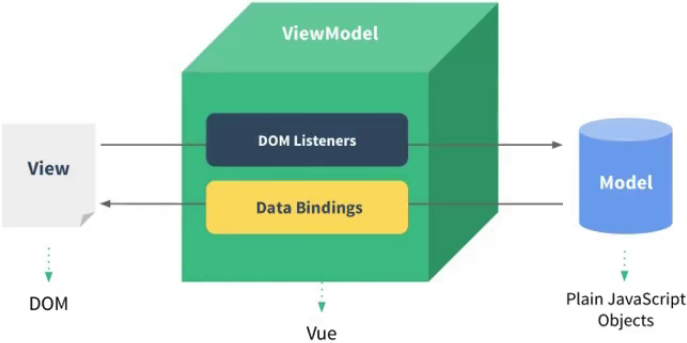
MVVM模型
- M:模型(Model): data中的数据
- V:视图(View): 模板代码
- VM:视图模型(ViewModel): Vue实例
观察发现:
- data中所有的属性,最后都出现在了vm身上。
- vm身上所有的属性及Vue原型上所有属性,在Vue模板中都可以直接使用。
1.7 数据代理
1.7.1 原生Object.defindProperty方法
<!DOCTYPE html>
<html lang="en">
<head>
<meta charset="UTF-8">
<meta http-equiv="X-UA-Compatible" content="IE=edge">
<meta name="viewport" content="width=device-width, initial-scale=1.0">
<title>Object.defindProperty</title>
</head>
<body>
<script type="text/javascript">
let Person = {
name:"张三",
sex:"男"
}
// 直接使用defineProperty,传入属性
// Object.defineProperty(Person, "age", {
// value:18, //传入的值
// enumerable:true, //控制属性是否可以枚举(遍历),默认值false
// writable:true, //控制属性的值是否可以被修改,默认值false
// configurable:true //控制属性是否可以别删除,默认值false
// })
// console.log(Person)
// console.log(Object.keys(Person))
// 使用defineProperty,传入变量
let age = 18
Object.defineProperty(Person, "age", {
get(){ //当age值被读取时,调用该方法,读取的值为返回的值
console.log("age属性被读取")
return age;
},
set(value){ //当age的值被修改时,修改的值会当作参数传入
console.log("age属性被修改")
age = value
}
})
</script>
</body>
</html>
1.7.2 数据代理
数据代理:通过一个对象代理对另一个对象中属性的操作(读/写
<!DOCTYPE html>
<html lang="en">
<head>
<meta charset="UTF-8">
<meta http-equiv="X-UA-Compatible" content="IE=edge">
<meta name="viewport" content="width=device-width, initial-scale=1.0">
<title>数据代理</title>
</head>
<body>
<script type="text/javascript">
let obj1 = {x:100}
let obj2 = {y:200}
Object.defineProperty(obj2, 'x', {
get(){
return obj1.x
},
set(value){
obj1.x = value
}
})
</script>
</body>
</html>
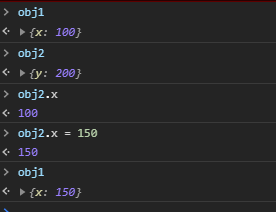
1.7.3 Vue中的数据代理
-
Vue中的数据代理:
通过vm对象来代理data对象中属性的操作(读/写)
-
Vue中数据代理的好处:
更加方便的操作data中的数据
-
基本原理:
通过object.defineProperty()把data对象中所有属性添加到vm上。为每一个添加到vm上的属性,都指定一个getter/setter。在getter/setter内部去操作(读/写)data中对应的属性。
<!DOCTYPE html> <html lang="en"> <head> <meta charset="UTF-8"> <meta name="viewport" content="width=device-width, initial-scale=1.0"> <meta http-equiv="X-UA-Compatible" content="ie=edge"> <title>vue数据代理</title> <script src="../js/vue.min.js"></script> </head> <body> <div id="app"> {{name}}{{_data.name}}<!--vue中真实数据在_data中--> </div> <script> Vue.config.productionTip=false //以阻止 vue 在启动时生成生产提示 const vm = new Vue({ el: '#app', data: { name:张三 } }) </script> </body> </html>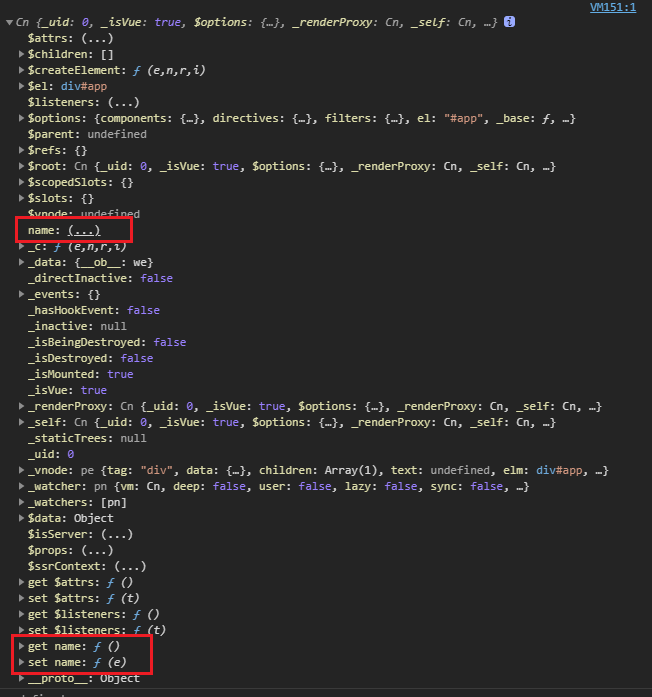
1.8 事件处理
1.8.1 事件的基本使用
-
使用v-on:xx或@x绑定事件,其中xxx是事件名
-
事件的回调需要配置在 methods对象中,最终会在vm上
-
methods中配置的函数,不要用箭头函数!否则this就不是vm了
-
methods中置的函数,都是被vue所管理的函数,this的指向是vm或组件实例对像
-
@c1ick="demo”和cick="demo($ event)"效果一致,但后者可以传参
<!DOCTYPE html>
<html lang="en">
<head>
<meta charset="UTF-8">
<meta name="viewport" content="width=device-width, initial-scale=1.0">
<meta http-equiv="X-UA-Compatible" content="ie=edge">
<title>事件处理</title>
<script src="../js/vue.min.js"></script>
</head>
<body>
<div id="app">
<h1>{{name}}</h1>
<button type="button" v-on:click="showInfo1">点我提示信息1</button>
<!-- v-on:click 可以简写为 @click -->
<button type="button" @click="showInfo2($event, '张三')">点我提示信息2</button>
</div>
<script>
Vue.config.productionTip=false //以阻止 vue 在启动时生成生产提示
const vm = new Vue({
el: '#app',
data: {
name:"hello world"
},
methods: {
showInfo1(event){ //默认点击时间会传入button的event
console.log(event)
console.log(event.target)
console.log(event.target.innerText)
alert("hello vue!")
},
showInfo2(event, name){ //调用方法时可用$event占位传入
console.log(this == vm) //this为vm
console.log(event)
console.log(event.target)
console.log(event.target.innerText)
alert("hello,"+name)
}
},
})
</script>
</body>
</html>
1.8.2 事件修饰符
Vue中的事件修饰符:
- prevent:阻止默认事件(常用);
- stop:阻止事件冒泡(常用);
- once:事件只触发一次(常用);
- capture:使用事件的捕获模式;
- self:只有event.target是当前操作的元素是才触发事件;
- passive:事件的默认行为立即执行,无需等待事件回调执行完毕;
<!DOCTYPE html>
<html lang="en">
<head>
<meta charset="UTF-8">
<meta name="viewport" content="width=device-width, initial-scale=1.0">
<meta http-equiv="X-UA-Compatible" content="ie=edge">
<title>事件修饰符</title>
<script src="../js/vue.min.js"></script>
<script src="http://apps.bdimg.com/libs/jquery/1.9.1/jquery.min.js"></script>
<style>
*{margin: 10px;}
.box1{
width: 100px;
height: 100px;
background-color: aquamarine;
}
.box2{
width: 50px;
height: 50px;
margin: 20;
background-color:cyan;
}
ul{
height: 300px;
width:120px;
background-color: darkorange;
padding: 10px;
overflow: auto;
}
li{
height: 150px;
width: 100px;
margin-top: 10px;
background-color: darksalmon;
}
</style>
</head>
<body>
<!-- Vue中的事件修饰符:
1. prevent:阻止默认事件(常用);
2. stop:阻止事件冒泡(常用);
3. once:事件只触发一次(常用);
4. capture:使用事件的捕获模式;
5. self:只有event.target是当前操作的元素是才触发事件;
6. passive:事件的默认行为立即执行,无需等待事件回调执行完毕; -->
<div id="app">
<!-- prevent:阻止默认事件(常用), 阻止a标签的跳转 -->
<a href="https://www.baidu.com" @click.prevent="showInfo">点我显示信息</a>
<!-- stop:阻止事件冒泡(常用) -->
<div class="box1" @click="showInfo2($event,'box')">
<button type="button" @click.stop="showInfo2($event, 'button')">button</button>
</div>
<!-- 修饰符可以一起使用 -->
<div class="box1" @click="showInfo2($event,'box')">
<a href="https://www.baidu.com" @click.stop.prevent="showInfo2($event, 'a')">a</a>
</div>
<!-- once:事件只触发一次(常用) -->
<button type="button" id="onceButton" @click.once="onceButton">once button</button>
<!-- capture:使用事件的捕获模式,(捕获阶段就开始处理) -->
<div class="box1" @click.capture="showInfo2($event,'box1')">
box1
<div class="box2" @click="showInfo2($event,'box2')">
box2
</div>
</div>
<!-- self:只有event.target是当前操作的元素是才触发事件 -->
<div class="box1" @click.self="showInfo2($event,'box1')">
box1
<div class="box2" @click="showInfo2($event,'box2')">
box2
</div>
</div>
<!-- passive:事件的默认行为立即执行,无需等待事件回调执行完毕; -->
<!-- @scroll:滚动条滚动事件(事件触发时默认行为立即执行) -->
<!-- @wheel:滚轮滚动事件(事件处理玩后才执行默认事件) -->
<ul @wheel.passive="demo">
<li>1</li>
<li>2</li>
<li>3</li>
<li>4</li>
<li>5</li>
</ul>
</div>
<script>
Vue.config.productionTip=false //以阻止 vue 在启动时生成生产提示
const vm = new Vue({
el: '#app',
data: {
},
methods: {
showInfo(event){
alert("hello vue")
console.log(event.target)
},
showInfo2(event, info){
console.log(info)
},
onceButton(event){
console.log(event.currentTarget.id)
$("#"+event.currentTarget.id).attr("disabled",true)
},
demo(){
for (let index = 0; index < 50000; index++) {
console.log("@")
}
alert("事件处理完成")
}
},
})
</script>
</body>
</html>
1.8.3 键盘事件
-
Vue中常用的按键别名:(真实名字首字母大写)
- 回车=>enter
- 删除=>delete(捕获“删除”和“退格”键)
- 退出=>esc
- 空格=>space
- 换行=>**tab **(必须配合@keydown使用)
- 上=>up
- 下=>down
- 左=>left
- 右=>right
-
Vue未提供别名的按键,可以使用按键原始的key值去绑定,但注意要转为kebab-case(短横线命名)
-
系统修饰键(用法特殊):ctrl、alt、shift、meta
- 配合keyup使用:按下修饰键的同时,再按下其他键,随后释放其他键,事件才被触发。
- 配合keydown使用:正常触发事件。
-
也可以使用keyCode去指定具体的按键(不推荐)
-
Vue.config.keyCodes.自定义键名=键码,可以去定制按键别名
<!DOCTYPE html>
<html lang="en">
<head>
<meta charset="UTF-8">
<meta name="viewport" content="width=device-width, initial-scale=1.0">
<meta http-equiv="X-UA-Compatible" content="ie=edge">
<title>helloworld</title>
<script src="../js/vue.min.js"></script>
<style>
*{
margin: 10px;
}
</style>
</head>
<body>
<!-- 1. Vue中常用的按键别名:
* 回车=>**enter**
* 删除=>**delete**(捕获“删除”和“退格”键)
* 退出=>**esc**
* 空格=>**space**
* 换行=>**tab**
* 上=>**up**
* 下=>**down**
* 左=>**left**
* 右=>**right**
2. Vue未提供别名的按键,可以使用按键原始的key值去绑定,但注意要转为kebab-case(短横线命名)
3. 系统修饰键(用法特殊):ctrl、alt、shift、meta
1. 配合keyup使用:按下修饰键的同时,再按下其他键,随后释放其他键,事件才被触发。
2. 配合keydown使用:正常触发事件。
4. 也可以使用keyCode去指定具体的按键(不推荐)
5. Vue.config.keyCodes.自定义键名=键码,可以去定制按键别名 -->
<div id="app">
<input type="text" placeholder="输入文字,回车键触发事件" @keyup.enter="showInfo"><br>
<input type="text" placeholder="输入文字,delete键触发事件" @keyup.delete="showInfo"><br>
<input type="text" placeholder="输入文字,esc键触发事件" @keyup.esc="showInfo"><br>
<input type="text" placeholder="输入文字,空格键触发事件" @keyup.space="showInfo"><br>
<input type="text" placeholder="输入文字,换行键触发事件" @keydown.tab="showInfo"><br>
<input type="text" placeholder="输入文字,上键触发事件" @keyup.up="showInfo"><br>
<input type="text" placeholder="输入文字,下键触发事件" @keyup.down="showInfo"><br>
<input type="text" placeholder="输入文字,左键触发事件" @keyup.left="showInfo"><br>
<input type="text" placeholder="输入文字,右键触发事件" @keyup.right="showInfo"><br>
<!-- 多个单词的按键小写中间用-连接,单个字母的首字母大写 -->
<input type="text" placeholder="输入文字,其它按键(大小写)触发事件" @keyup.caps-lock="showInfo"><br>
<!-- 系统修饰键(用法特殊):ctrl、alt、shift、meta -->
<input type="text" placeholder="输入文字,ctrl+其他按键触发事件触发事件" @keyup.ctrl="showInfo"><br>
<input type="text" placeholder="输入文字,ctrl+y键触发事件触发事件" @keyup.ctrl.y="showInfo"><br>
<!-- 自定义按键别名 -->
<input type="text" placeholder="输入文字,回车键触发事件" @keyup.huiche="showInfo"><br>
</div>
<script>
Vue.config.productionTip=false //以阻止 vue 在启动时生成生产提示
Vue.config.keyCodes.huiche=13 //自定义按键别名
const vm = new Vue({
el: '#app',
data: {
},
methods: {
showInfo(event){
console.log(event.key,event.keyCode)
console.log(event.target.value)
alert(event.target.value)
}
},
})
</script>
</body>
</html>
1.9 计算属性
案例要求:两个输入框分别输入姓和名,下方将姓名文字组合在一起
1.9.1 插值语法实现
<!DOCTYPE html>
<html lang="en">
<head>
<meta charset="UTF-8">
<meta name="viewport" content="width=device-width, initial-scale=1.0">
<meta http-equiv="X-UA-Compatible" content="ie=edge">
<title>helloworld</title>
<script src="../js/vue.min.js"></script>
</head>
<body>
<div id="app">
<input type="text" v-model="firstName"> <br>
<input type="text" v-model="lastName"> <br>
姓名:{{firstName}}-{{lastName}}
</div>
<script>
Vue.config.productionTip=false //以阻止 vue 在启动时生成生产提示
const vm = new Vue({
el: '#app',
data: {
firstName: "张",
lastName: "三"
}
})
</script>
</body>
</html>
1.9.2 methods方法实现
<!DOCTYPE html>
<html lang="en">
<head>
<meta charset="UTF-8">
<meta name="viewport" content="width=device-width, initial-scale=1.0">
<meta http-equiv="X-UA-Compatible" content="ie=edge">
<title>helloworld</title>
<script src="../js/vue.min.js"></script>
</head>
<body>
<div id="app">
<input type="text" v-model="firstName"> <br>
<input type="text" v-model="lastName"> <br>
姓名:{{showName()}}
</div>
<script>
Vue.config.productionTip=false //以阻止 vue 在启动时生成生产提示
const vm = new Vue({
el: '#app',
data: {
firstName: "张",
lastName: "三"
},
methods: {
showName(){
return this.firstName + "-" + this.lastName
}
},
})
</script>
</body>
</html>
1.9.3 计算属性
计算属性:
- 定义:要用的属性不存在,要通过已有属性计算得来。
- 原理:底层借助了objcet.defineproperty方法提供的getter和setter。
- get雨敬什么时候执行?
- 初次读取时会执行一次。
- 当依赖的数据发生改变时会被再次调用。
- 优势:与methods实现相比,内部有缓存机制(复用),效率更高,调试方便。
- 备注:
- 计算属性最终会出现在vm上,直接读取使用即可。
- 如果计算属性要被修改,那必须写set两数去响应修改,且set中要引起计算时依赖的数据发变化
<!DOCTYPE html>
<html lang="en">
<head>
<meta charset="UTF-8">
<meta name="viewport" content="width=device-width, initial-scale=1.0">
<meta http-equiv="X-UA-Compatible" content="ie=edge">
<title>helloworld</title>
<script src="../js/vue.min.js"></script>
</head>
<body>
<div id="app">
<input type="text" v-model="firstName"> <br>
<input type="text" v-model="lastName"> <br>
姓名:{{fullName}}
</div>
<script>
Vue.config.devtools = true
Vue.config.productionTip=false //以阻止 vue 在启动时生成生产提示
const vm = new Vue({
el: '#app',
data: {
firstName: "张",
lastName: "三"
},
computed:{
fullName:{
//get有什么作用?当有人读取fullName时,get就会被调用,且返回值就作为fullName的值
//get什么时候调用?1.初次读取fullName时。2.所依赖的数据发生变化时。
get(){
console.log('get 方法被调用了')
return this.firstName + "-" + this.lastName
},
//候调用?当fullName被修改时。
set(value){
let arr = value.split("-")
this.firstName = arr[0]
this.lastName = arr[1]
}
}
}
})
</script>
</body>
</html>
简写形式:
<!DOCTYPE html>
<html lang="en">
<head>
<meta charset="UTF-8">
<meta name="viewport" content="width=device-width, initial-scale=1.0">
<meta http-equiv="X-UA-Compatible" content="ie=edge">
<title>helloworld</title>
<script src="../js/vue.min.js"></script>
</head>
<body>
<div id="app">
<input type="text" v-model="firstName"> <br>
<input type="text" v-model="lastName"> <br>
姓名:{{fullName}}
</div>
<script>
Vue.config.devtools = true
Vue.config.productionTip=false //以阻止 vue 在启动时生成生产提示
const vm = new Vue({
el: '#app',
data: {
firstName: "张",
lastName: "三"
},
computed:{
fullName(){ //不考虑修改计算属性的情况下,可简写为函数形式,相当于直接调用了get方法
return this.firstName + "-" + this.lastName
}
}
})
</script>
</body>
</html>
1.10 监视属性
案例:实现页面显示的天气状态的改变
1.10.1 使用插值语法实现
<!DOCTYPE html>
<html lang="en">
<head>
<meta charset="UTF-8">
<meta name="viewport" content="width=device-width, initial-scale=1.0">
<meta http-equiv="X-UA-Compatible" content="ie=edge">
<title>helloworld</title>
<script src="../js/vue.min.js"></script>
</head>
<body>
<div id="app">
<h1>今天的天气{{showWeacher}}</h1>
<button type="button" @click="switchWeather">点击切换</button>
</div>
<script>
Vue.config.devtools = true //使用VueTools工具进行调试
Vue.config.productionTip=false //以阻止 vue 在启动时生成生产提示
const vm = new Vue({
el: '#app',
data: {
isHot:true
},
methods: {
switchWeather(){
this.isHot = !this.isHot
}
},
computed:{
showWeacher(){
return this.isHot ? "炎热":"凉爽"
}
}
})
</script>
</body>
</html>
1.10.2 监视属性
监视属性watch:
- 当被监视的属性变化时,回调函数自动调用,进行相关操作
- 监视的属性必须存在,才能进行监视!!
- 监视的两种写法:
- new Vue时传入watch配置
- 通过vm.$watch监视
<!DOCTYPE html>
<html lang="en">
<head>
<meta charset="UTF-8">
<meta name="viewport" content="width=device-width, initial-scale=1.0">
<meta http-equiv="X-UA-Compatible" content="ie=edge">
<title>helloworld</title>
<script src="../js/vue.min.js"></script>
</head>
<body>
<div id="app">
<h1>今天的天气{{showWeacher}}</h1>
<button type="button" @click="switchWeather">点击切换</button>
</div>
<script>
Vue.config.devtools = true //使用VueTools工具进行调试
Vue.config.productionTip=false //以阻止 vue 在启动时生成生产提示
const vm = new Vue({
el: '#app',
data: {
isHot:true
},
methods: {
switchWeather(){
this.isHot = !this.isHot
}
},
computed:{
showWeacher(){
return this.isHot ? "炎热":"凉爽"
}
},
watch:{
isHot:{
immediate:true, //初始化时让handler调用一下
handler(newValue, oldVale){ //handler什么时候调用?当isHot发生改变时。
console.log("new value: "+ newValue + ", old value: " + oldVale)
}
}
}
})
// 第二种写法
// vm.$watch("isHot",{
// immediate:true, //初始化时让handler调用一下
// handler(newValue, oldVale){ //handler什么时候调用?当isHot发生改变时。
// console.log("new value: "+ newValue + ", old value: " + oldVale)
// }
// })
</script>
</body>
</html>
1.10.3 深度监视
深度监视:
- Vue中的watch默认不监测对象内部值的改变(一层)。
- 配置deep:true可以监测对象内部值改变(多层)。
备注:
- Vue自身可以监测对象内部值的改变,但Vue提供的watch默认不可以
- 使用watch时根据数据的具体结构,决定是否采用深度监视。
<!DOCTYPE html>
<html lang="en">
<head>
<meta charset="UTF-8">
<meta name="viewport" content="width=device-width, initial-scale=1.0">
<meta http-equiv="X-UA-Compatible" content="ie=edge">
<title>helloworld</title>
<script src="../js/vue.min.js"></script>
</head>
<body>
<div id="app">
<h1>今天的天气{{showWeacher}}</h1>
<button type="button" @click="switchWeather">点击切换</button>
<hr>
<h2>{{number.a}}</h2>
<button type="button" @click="number.a++">点我+1</button>
</div>
<script>
Vue.config.devtools = true //使用VueTools工具进行调试
Vue.config.productionTip=false //以阻止 vue 在启动时生成生产提示
const vm = new Vue({
el: '#app',
data: {
isHot:true,
number:{
a: 1,
b: 1
}
},
methods: {
switchWeather(){
this.isHot = !this.isHot
}
},
computed:{
showWeacher(){
return this.isHot ? "炎热":"凉爽"
}
},
watch:{
isHot:{
immediate:true, //初始化时让handler调用一下
handler(newValue, oldVale){ //handler什么时候调用?当isHot发生改变时。
console.log("new value: "+ newValue + ", old value: " + oldVale)
}
},
"number.a":{ //监控多级属性种的某一个属性发生变化
immediate:true, //初始化时让handler调用一下
handler(newValue, oldVale){ //handler什么时候调用?当isHot发生改变时。
console.log("new value: "+ newValue + ", old value: " + oldVale)
}
},
number:{ //监控多级属性种的所有值的变化
deep:true,
immediate:true, //初始化时让handler调用一下
handler(newValue, oldVale){ //handler什么时候调用?当isHot发生改变时。
console.log("new value: "+ JSON.stringify(newValue) + ", old value: " + JSON.stringify(oldVale))
}
}
}
})
</script>
</body>
</html>
1.10.4 简写
<!DOCTYPE html>
<html lang="en">
<head>
<meta charset="UTF-8">
<meta name="viewport" content="width=device-width, initial-scale=1.0">
<meta http-equiv="X-UA-Compatible" content="ie=edge">
<title>helloworld</title>
<script src="../js/vue.min.js"></script>
</head>
<body>
<div id="app">
<h1>今天的天气{{showWeacher}}</h1>
<button type="button" @click="switchWeather">点击切换</button>
</div>
<script>
Vue.config.devtools = true //使用VueTools工具进行调试
Vue.config.productionTip=false //以阻止 vue 在启动时生成生产提示
const vm = new Vue({
el: '#app',
data: {
isHot:true
},
methods: {
switchWeather(){
this.isHot = !this.isHot
}
},
computed:{
showWeacher(){
return this.isHot ? "炎热":"凉爽"
}
},
watch:{
//完整写法
// isHot:{
// immediate:true, //初始化时让handler调用一下
// handler(newValue, oldVale){ //handler什么时候调用?当isHot发生改变时。
// console.log("new value: "+ newValue + ", old value: " + oldVale)
// }
// }
//简写,只需要监控,不需要其他属性
// isHot(newValue, oldVale){
// console.log("new value: "+ newValue + ", old value: " + oldVale)
// }
}
})
// 第二种写法
// vm.$watch("isHot",{
// immediate:true, //初始化时让handler调用一下
// handler(newValue, oldVale){ //handler什么时候调用?当isHot发生改变时。
// console.log("new value: "+ newValue + ", old value: " + oldVale)
// }
// })
//简写形式
vm.$watch("isHot",function(newValue, oldVale){
console.log("new value: "+ newValue + ", old value: " + oldVale)
})
</script>
</body>
</html>
1.10.5 watch实现姓名案例
computed和watch之间的区别:
- computed能完成的功能,watch都可以完成。
- watch能完成的功能,computed不一定能完成,例如:watch可以进行异步操作。
两个重要的小原则:
- 所被Vue管理的函数,最好写成普通函数,这样this的指向才是vm或组件实例对象。
- 所有不被Vue所管理的函数(定时器的回调函数、ajax的回调函数等、Promise的回调函数),最好写成箭头函刻,这样this的指向才是vm或组件实例对象。
<!DOCTYPE html>
<html lang="en">
<head>
<meta charset="UTF-8">
<meta name="viewport" content="width=device-width, initial-scale=1.0">
<meta http-equiv="X-UA-Compatible" content="ie=edge">
<title>helloworld</title>
<script src="../js/vue.min.js"></script>
</head>
<body>
<div id="app">
<input type="text" v-model="firstName"> <br>
<input type="text" v-model="lastName"> <br>
姓名:{{fullName}}
</div>
<script>
Vue.config.devtools = true
Vue.config.productionTip=false //以阻止 vue 在启动时生成生产提示
const vm = new Vue({
el: '#app',
data: {
firstName: "张",
lastName: "三",
fullName: "张 - 三"
},
// computed:{
// fullName(){ //不考虑修改计算属性的情况下,可简写为函数形式,相当于直接调用了get方法
// return this.firstName + "-" + this.lastName
// }
// }
watch:{
firstName(value){ //需要使用异步的只能使用watch而不能使用computed
console.log("firstName...")
setTimeout(()=>{
this.fullName = value + this.lastName
}, 1000) //一秒响应
},
lastName(value){
console.log("lastName...")
setTimeout(()=>{
this.fullName = this.firstName + value
}, 1000) //一秒响应
},
}
})
</script>
</body>
</html>
1.11 样式绑定
绑定样式:
-
class样式
写法:class="xxx"xxx可以是字符串、对象、数组。
- 字符串写法适用于:类名不确定,要动态获取。
- 对象写法适用于:要绑定多个样式,个数不确定,名字也不确定。
- 数组写法适用于:要绑定多个样式,个数确定,名字也确定,但不确定用不用。
-
style样式
- :style="{fontSize:xxx}"其中xxx是动态值。
- :style="[a,b]"其中a、b是样式对象。
1.11.1 css绑定
<!DOCTYPE html>
<html lang="en">
<head>
<meta charset="UTF-8">
<meta name="viewport" content="width=device-width, initial-scale=1.0">
<meta http-equiv="X-UA-Compatible" content="ie=edge">
<title>helloworld</title>
<script src="../js/vue.min.js"></script>
<style>
.base{
width: 300px;
height: 300px;
border: 1px solid #000;
padding: 5%;
margin-top: 10px;
}
.common{
background: rgb(182,214,237);
background: -moz-linear-gradient(left, rgb(182,214,237) 0%, rgb(113,189,239) 55%, rgb(34,156,226) 100%);
background: -webkit-gradient(left top, right top, color-stop(0%, rgb(182,214,237)), color-stop(55%, rgb(113,189,239)), color-stop(100%, rgb(34,156,226)));
background: -webkit-linear-gradient(left, rgb(182,214,237) 0%, rgb(113,189,239) 55%, rgb(34,156,226) 100%);
background: -o-linear-gradient(left, rgb(182,214,237) 0%, rgb(113,189,239) 55%, rgb(34,156,226) 100%);
background: -ms-linear-gradient(left, rgb(182,214,237) 0%, rgb(113,189,239) 55%, rgb(34,156,226) 100%);
background: linear-gradient(to right, rgb(182,214,237) 0%, rgb(113,189,239) 55%, rgb(34,156,226) 100%);
filter: progid:DXImageTransform.Microsoft.gradient( startColorstr='#b6d6ed', endColorstr='#229ce2', GradientType=1 );
}
.happy{
background: rgb(255,215,82);
background: -moz-linear-gradient(left, rgb(255,215,82) 0%, rgb(229,231,64) 39%, rgb(241,91,146) 100%);
background: -webkit-gradient(left top, right top, color-stop(0%, rgb(255,215,82)), color-stop(39%, rgb(229,231,64)), color-stop(100%, rgb(241,91,146)));
background: -webkit-linear-gradient(left, rgb(255,215,82) 0%, rgb(229,231,64) 39%, rgb(241,91,146) 100%);
background: -o-linear-gradient(left, rgb(255,215,82) 0%, rgb(229,231,64) 39%, rgb(241,91,146) 100%);
background: -ms-linear-gradient(left, rgb(255,215,82) 0%, rgb(229,231,64) 39%, rgb(241,91,146) 100%);
background: linear-gradient(to right, rgb(255,215,82) 0%, rgb(229,231,64) 39%, rgb(241,91,146) 100%);
filter: progid:DXImageTransform.Microsoft.gradient( startColorstr='#ffd752', endColorstr='#f15b92', GradientType=1 );
}
.unhappy{
background: rgb(221,181,235);
background: -moz-linear-gradient(left, rgb(221,181,235) 0%, rgb(113,189,239) 47%, rgb(235,168,35) 100%);
background: -webkit-gradient(left top, right top, color-stop(0%, rgb(221,181,235)), color-stop(47%, rgb(113,189,239)), color-stop(100%, rgb(235,168,35)));
background: -webkit-linear-gradient(left, rgb(221,181,235) 0%, rgb(113,189,239) 47%, rgb(235,168,35) 100%);
background: -o-linear-gradient(left, rgb(221,181,235) 0%, rgb(113,189,239) 47%, rgb(235,168,35) 100%);
background: -ms-linear-gradient(left, rgb(221,181,235) 0%, rgb(113,189,239) 47%, rgb(235,168,35) 100%);
background: linear-gradient(to right, rgb(221,181,235) 0%, rgb(113,189,239) 47%, rgb(235,168,35) 100%);
filter: progid:DXImageTransform.Microsoft.gradient( startColorstr='#ddb5eb', endColorstr='#eba823', GradientType=1 );
}
.border1{
border:darkorchid solid 2px;
}
.border2{
border-radius: 20px;
}
.border3{
box-shadow: gray 5px 2px;
}
</style>
</head>
<body>
<div id="app">
<!--绑定class样式--字符串写法,适用于:样式的类名不确定,需要动态指定 -->
<div class="base" :class="bgColor" @click="changeBgColor">
心情{{mood}}
</div>
<!--绑定c1ass样式--数组写法,适用于:要绑定的样式个数不确定、名字也不确定-->
<div class="base" :class="arr" @click="changeBorderStyle">
使用样式:{{arr}}
</div>
<!--绑定class样式--对象写法,适用于:要绑定的样式个数确定、名字也确定,但要动态决定用不用 -->
<div class="base" :class="selectArr">
<input type="checkbox" v-model="selectArr.border1" > border1 <br>
<input type="checkbox" v-model="selectArr.border2"> border3 <br>
<input type="checkbox" v-model="selectArr.border3" > border3 <br>
</div>
</div>
<script>
Vue.config.devtools = true //使用VueTools工具进行调试
Vue.config.productionTip=false //以阻止 vue 在启动时生成生产提示
const vm = new Vue({
el: '#app',
data: {
bgColor: "common",
mood:"平常心",
arr:[],
selectArr:{
border1:false,
border2:false,
border3:false
}
},
methods: {
changeBgColor(){
const arrBgColor = ["common","happy","unhappy"]
const arrMood = ["平常心","开心","不开心"]
let index = Math.floor(Math.random()*3)
this.bgColor = arrBgColor[index]
this.mood = arrMood[index]
},
changeBorderStyle(){
const style = ["border1", "border2", "border3"]
if(this.arr.length < 3)
this.arr.push(style[this.arr.length])
},
},
})
</script>
</body>
</html>
1.22.2 style绑定
<!DOCTYPE html>
<html lang="en">
<head>
<meta charset="UTF-8">
<meta name="viewport" content="width=device-width, initial-scale=1.0">
<meta http-equiv="X-UA-Compatible" content="ie=edge">
<title>helloworld</title>
<script src="../js/vue.min.js"></script>
<style>
.base{
width: 200px;
height: 200px;
border: 1px solid #000;
padding: 5%;
margin-top: 10px;
}
</style>
</head>
<body>
<div id="app">
<div class="base" :style="{borderRadius: borderRadius}">
style绑定
</div>
<div class="base" :style="style">
style绑定
</div>
<div class="base" :style="[{backgroundColor,backgroundColor}, {borderRadius, borderRadius}]">
style绑定
</div>
</div>
<script>
Vue.config.devtools = true //使用VueTools工具进行调试
Vue.config.productionTip=false //以阻止 vue 在启动时生成生产提示
const vm = new Vue({
el: '#app',
data: {
borderRadius: '15px',
backgroundColor: 'red',
style:{
borderRadius: '15px',
backgroundColor: 'red',
}
},
methods: {
},
})
</script>
</body>
</html>
1.12 条件渲染
条件渲染:
-
v-if
写法:- v-if=“表达式”
- v-else-if=“表达式”
- v-else=“表达式”
适用于:切换频率较低的场景。
特点:不展示的DOM元素直接被移除。
注意:v-if可以和:v-else-if、v-else一起使用,但要求结构不能被“打断”。
-
v-show
写法:V-show=“表达式”
适用于:切换频率较高的场景。
特点:不展示的DOM元素未被移除,仅仅是使用样式隐藏掉
-
备注:使用v-if的时,元素可能无法获取到,而使用v-show一定可以获取到。
<!DOCTYPE html>
<html lang="en">
<head>
<meta charset="UTF-8">
<meta name="viewport" content="width=device-width, initial-scale=1.0">
<meta http-equiv="X-UA-Compatible" content="ie=edge">
<title>helloworld</title>
<script src="../js/vue.min.js"></script>
</head>
<body>
<div id="app">
<div v-show="true">v-show</div>
<div v-show="1===3">v-show</div>
<div v-show="isShow">v-show</div>
<hr>
<div v-if="true">v-if</div>
<div v-if="1===3">v-if</div>
<div v-if="isShow">v-if</div>
<hr>
计数器:{{count}} <button @click="count++">点击+1</button>
<div v-if="count === 1">tony</div>
<div v-if="count === 2">admin</div>
<div v-if="count === 3">pony</div>
<template v-if="count > 3"> <!--在页面解析的时候不会显示template标签,不破坏结构-->
<hr>
<div>张三</div>
<div>李四</div>
<div>王五</div>
</template>
<hr>
<div v-if="count === 1">hello</div> <!--v-else-if和v-else不能跟v-if中间打断-->
<div v-else-if="count === 2">world</div>
<div v-else >hello world</div>
</div>
<script>
Vue.config.devtools = true //使用VueTools工具进行调试
Vue.config.productionTip=false //以阻止 vue 在启动时生成生产提示
const vm = new Vue({
el: '#app',
data: {
info:"helloworld",
isShow:true,
count:0
}
})
</script>
</body>
</html>
1.13 列表渲染
1.13.1 基本列表
v-for指令:
- 用于展示列表数据
- 语法:v-for="(item,index)in xxx" :key=“yyy”
- 可遍历:数组、对象、字符串(用的很少)、指定次数(用的很少)
<!DOCTYPE html>
<html lang="en">
<head>
<meta charset="UTF-8">
<meta name="viewport" content="width=device-width, initial-scale=1.0">
<meta http-equiv="X-UA-Compatible" content="ie=edge">
<title>helloworld</title>
<script src="../js/vue.min.js"></script>
</head>
<body>
<div id="app">
<h1>解析列表信息</h1>
<ul>
<li v-for="(item,index) in persons" :key="index">{{item.name}}-{{item.age}}</li>
</ul>
<h1>解析对象信息</h1>
<ul>
<li v-for="(value,key) in car" :key="key">{{key}}-{{value}}</li>
</ul>
<h1>解析字符串</h1>
<ul>
<li v-for="(char,index) in say" :key="index">"{{char}}"-{{index}}</li>
</ul>
<h1>解析数字</h1>
<ul>
<li v-for="(number,index) in 10" :key="index">"{{number}}"-{{index}}</li>
</ul>
</div>
<script>
Vue.config.devtools = true //使用VueTools工具进行调试
Vue.config.productionTip=false //以阻止 vue 在启动时生成生产提示
const vm = new Vue({
el: '#app',
data: {
persons:[
{id:"001",name:"张三",age:"18"},
{id:"002",name:"李四",age:"19"},
{id:"003",name:"王五",age:"20"}
],
car:{
name:"hq",
price:1000000,
color: "black"
},
say:"hello world"
}
})
</script>
</body>
</html>
1.13.2 key原理
面试题:react、vue中的key有什么作用?(key的内部原理)
- 虚拟DOM中key的作用:
- key是虚拟DOM对象的标识,当数据发生变化时,Vue会根据【新数据】生成【新的虚拟DOM】
- 随后Vue进行【新虚拟DOM】与【旧虚拟DOM】的差异比较,比较规则如下:
- 对比规则:
- 旧虚拟DOM中找到了与新虚拟DOM相同的key:
- 若虚拟DOM中内容没变,直接使用之前的真实DOM!
- 若虚拟DOM中内容变了,则生成新的真实DOM,随后替换掉页面中之前的真DOM。
- 旧虚拟DOM中未找到与新虚拟DOM相同的key
- 创建新的真实DOM,随后渲染到到页面。
- 旧虚拟DOM中找到了与新虚拟DOM相同的key:
- 用index作为key可能会引发的问题:
- 若对数据进行:逆序添加、逆序删除等破坏顺序操作:
- 会产生没有必要的真实DOM更新==》界面效果没问题,但效率低。
- 如果结构中还包含输入类的DOM:
- 会产生错误DOM更新==》界面有问题。
- 若对数据进行:逆序添加、逆序删除等破坏顺序操作:
<!DOCTYPE html>
<html lang="en">
<head>
<meta charset="UTF-8">
<meta name="viewport" content="width=device-width, initial-scale=1.0">
<meta http-equiv="X-UA-Compatible" content="ie=edge">
<title>helloworld</title>
<script src="../js/vue.min.js"></script>
</head>
<body>
<div id="app">
<h1>解析列表信息,key为index</h1>
<ul>
<li v-for="(item,index) in persons" :key="index">
{{item.name}}-{{item.age}} <input type="text">
</li>
</ul>
<h1>解析列表信息,key为id</h1>
<ul>
<li v-for="(item,index) in persons" :key="item.id">
{{item.name}}-{{item.age}} <input type="text">
</li>
</ul>
<button @click.once="addPerson">添加一个用户</button>
</div>
<script>
Vue.config.devtools = true //使用VueTools工具进行调试
Vue.config.productionTip=false //以阻止 vue 在启动时生成生产提示
const vm = new Vue({
el: '#app',
data: {
persons:[
{id:"001",name:"张三",age:"18"},
{id:"002",name:"李四",age:"19"},
{id:"003",name:"王五",age:"20"}
]
},
methods: {
addPerson(){
const person = {id:"004",name:"赵六",age:"20"}
this.persons.unshift(person)
}
},
})
</script>
</body>
</html>
1.13.4 列表过滤
<!DOCTYPE html>
<html lang="en">
<head>
<meta charset="UTF-8">
<meta name="viewport" content="width=device-width, initial-scale=1.0">
<meta http-equiv="X-UA-Compatible" content="ie=edge">
<title>helloworld</title>
<script src="../js/vue.min.js"></script>
</head>
<body>
<div id="app">
<h1>模糊搜索-watch实现</h1>
<input type="text" v-model="keyWord" placeholder="请输入姓名" />
<ul>
<li v-for="(item,index) in searchResult" :key="item.id">
姓名:{{item.name}},年龄:{{item.age}},性别:{{item.sex}}
</li>
</ul>
<h1>模糊搜索-computed实现</h1>
<input type="text" v-model="keyWord2" placeholder="请输入姓名" />
<ul>
<li v-for="(item,index) in searchResult2" :key="item.id">
姓名:{{item.name}},年龄:{{item.age}},性别:{{item.sex}}
</li>
</ul>
</div>
<script>
Vue.config.devtools = true //使用VueTools工具进行调试
Vue.config.productionTip=false //以阻止 vue 在启动时生成生产提示
const vm = new Vue({
el: '#app',
data: {
keyWord:"",
keyWord2:"",
persons:[
{id:"001",name:"张三",age:"18", sex:"男"},
{id:"002",name:"李四",age:"19", sex:"男"},
{id:"003",name:"王五",age:"20", sex:"男"},
{id:"004",name:"赵六",age:"20", sex:"女"},
{id:"004",name:"赵七",age:"20", sex:"女"}
],
searchResult:[],
},
computed:{
searchResult2(){
return this.persons.filter((p)=>{
return p.name.indexOf(this.keyWord2) !== -1
})
}
},
watch:{
keyWord:{
immediate:true, //初始化时执行handler
handler(val){
this.searchResult = this.persons.filter((p)=>{
return p.name.indexOf(val) !== -1
})
}
}
}
})
</script>
</body>
</html>
1.13.4 列表排序
<!DOCTYPE html>
<html lang="en">
<head>
<meta charset="UTF-8">
<meta name="viewport" content="width=device-width, initial-scale=1.0">
<meta http-equiv="X-UA-Compatible" content="ie=edge">
<title>helloworld</title>
<script src="../js/vue.min.js"></script>
<style>
table{
border: 1px solid #000;
margin: 0 auto;
}
td{
padding:10px 60px;
text-align: left;
}
</style>
</head>
<body>
<div id="app">
<table>
<tr>
<th>id</th>
<th>姓名</th>
<th>年龄 <br/>
<button type="button" @click="changeSortType(0)">○</button>
<button type="button" @click="changeSortType(1)">↑</button>
<button type="button" @click="changeSortType(2)">↓</button>
</th>
<th>性别</th>
</tr>
<tr v-for="(item,index) in searchResult" :key="item.id">
<td>{{item.id}}</td>
<td>{{item.name}}</td>
<td>{{item.age}}</td>
<td>{{item.sex}}</td>
</tr>
<tr>
<td colspan="4"><input type="text" v-model="keyWord" placeholder="请输入姓名" ></td>
</tr>
</table>
</div>
<script>
Vue.config.devtools = true //使用VueTools工具进行调试
Vue.config.productionTip=false //以阻止 vue 在启动时生成生产提示
const vm = new Vue({
el: '#app',
data: {
keyWord:"",
sortType:0,
persons:[
{id:"001",name:"张三",age:"18", sex:"男"},
{id:"002",name:"李四",age:"19", sex:"男"},
{id:"003",name:"王五",age:"17", sex:"男"},
{id:"004",name:"赵六",age:"25", sex:"女"},
{id:"004",name:"赵七",age:"23", sex:"女"}
],
},
methods: {
changeSortType(type){
this.sortType = type
}
},
computed:{
searchResult(){
const arr = this.persons.filter((p)=>{
return p.name.indexOf(this.keyWord) !== -1
})
if(this.sortType){
arr.sort((p1,p2)=>{ // p1 - p2升序,p2 - p1 降序
return this.sortType === 1 ? p1.age - p2.age : p2.age - p1.age
})
}
return arr;
}
}
})
</script>
</body>
</html>
1.13.5 数据更新时的小问题
分别修改列表中对象的每一个属性时,vue会检测到,页面会立即响应。
直接修改列表中的一个对象时,vue不会检测到,代码层面数据生效,但页面不会立即生效。
<!DOCTYPE html>
<html lang="en">
<head>
<meta charset="UTF-8">
<meta name="viewport" content="width=device-width, initial-scale=1.0">
<meta http-equiv="X-UA-Compatible" content="ie=edge">
<title>helloworld</title>
<script src="../js/vue.min.js"></script>
</head>
<body>
<div id="app">
<ul>
<li v-for="(item, index) in persons" :key="item.id">
{{item.id}}--{{item.name}}--{{item.age}}--{{item.sex}}
</li>
</ul>
<button type="button" @click="changeInfo">修改张三信息(正常修改)</button>
<button type="button" @click="changeInfo2">修改张三信息(异常修改)</button>
</div>
<script>
Vue.config.devtools = true //使用VueTools工具进行调试
Vue.config.productionTip=false //以阻止 vue 在启动时生成生产提示
const vm = new Vue({
el: '#app',
data: {
persons:[
{id:"001",name:"张三",age:"18", sex:"男"},
{id:"002",name:"李四",age:"19", sex:"男"},
{id:"003",name:"王五",age:"17", sex:"男"},
{id:"004",name:"赵六",age:"25", sex:"女"},
{id:"004",name:"赵七",age:"23", sex:"女"}
],
},
methods: {
changeInfo(){ //页面立即响应
this.persons[0].name = "hello",
this.persons[1].age = "22"
},
changeInfo2(){ //后台数据发生变化,页面不响应
this.persons[0] = {id:"001",name:"world",age:"22", sex:"男"}
}
},
})
</script>
</body>
</html>
1.14 数据监测原理
1.14.1 模拟vue数据监测
单层对象的数据监测
<!DOCTYPE html>
<html lang="en">
<head>
<meta charset="UTF-8">
<meta http-equiv="X-UA-Compatible" content="IE=edge">
<meta name="viewport" content="width=device-width, initial-scale=1.0">
<title>Document</title>
</head>
<body>
</body>
<script type="text/javascript">
let data = {
name:"zs",
age: 18
}
//创建一个监视对象,用于监视data中属性的变化
const obs = new Obsrever(data);
console.log(obs)
//创建一个vm实例
let vm = {}
vm._data = data = obs
function Obsrever(obj){
//汇总对象中的所有属性形成一个数组
const keys = Object.keys(obj)
//遍历数组
keys.forEach((k)=>{
Object.defineProperty(this, k,{
get(){
return obj[k]
},
set(val){
obj[k] = val
}
})
})
}
</script>
</html>
1.14.2 Vue.set()方法
向响应式对象中添加一个 property,并确保这个新 property 同样是响应式的,且触发视图更新。它必须用于向响应式对象上添加新 property,
注意对象不能是 Vue 实例,或者 Vue 实例的根数据对象。
<!DOCTYPE html>
<html lang="en">
<head>
<meta charset="UTF-8">
<meta name="viewport" content="width=device-width, initial-scale=1.0">
<meta http-equiv="X-UA-Compatible" content="ie=edge">
<title>helloworld</title>
<script src="../js/vue.min.js"></script>
<script src="http://libs.baidu.com/jquery/2.0.0/jquery.min.js"></script>
</head>
<body>
<div id="app">
<h1>学生信息</h1>
<ul>
<li v-for="(value, key) in person">
{{key}}-- {{value}}
</li>
</ul>
<h2>添加学生信息</h2>
字段名:<input type="text" id="key">
值:<input type="text" id="value">
<button type="button" @click="add" >添加</button>
</div>
<script>
Vue.config.devtools = true //使用VueTools工具进行调试
Vue.config.productionTip=false //以阻止 vue 在启动时生成生产提示
const vm = new Vue({
el: '#app',
data: {
person:{
name:"张三",
age: 20,
sex: "男",
},
},
methods: {
add(){
let key = $("#key").val()
let value = $("#value").val()
// Vue.set(vm.person, key, value)
vm.$set(vm.person, key, value)
}
},
})
</script>
</body>
</html>
1.14.3 数组数据监测
Vue 将被侦听的数组的变更方法进行了包裹,所以它们也将会触发视图更新。这些被包裹过的方法包括:
push()pop()shift()unshift()splice()sort()reverse()
<!DOCTYPE html>
<html lang="en">
<head>
<meta charset="UTF-8">
<meta name="viewport" content="width=device-width, initial-scale=1.0">
<meta http-equiv="X-UA-Compatible" content="ie=edge">
<title>helloworld</title>
<script src="../js/vue.min.js"></script>
</head>
<body>
<div id="app">
<ul>
<li v-for="(item, index) in persons" :key="item.id">
{{item.id}}--{{item.name}}--{{item.age}}--{{item.sex}}
</li>
</ul>
<input type="button" value="修改张三信息(使用下标修改)" @click="update1">
<input type="button" value="修改张三信息(使用方法修改)" @click="update2">
</div>
<script>
Vue.config.devtools = true //使用VueTools工具进行调试
Vue.config.productionTip=false //以阻止 vue 在启动时生成生产提示
const vm = new Vue({
el: '#app',
data: {
persons:[
{id:"001",name:"张三",age:"18", sex:"男"},
{id:"002",name:"李四",age:"19", sex:"男"},
{id:"003",name:"王五",age:"17", sex:"男"},
{id:"004",name:"赵六",age:"25", sex:"女"},
{id:"005",name:"赵七",age:"23", sex:"女"}
],
},
methods: {
update1(){
this.persons[0] = {id:"001",name:"pony",age:"19", sex:"男"}
console.log(this.persons[0])
},
update2(){
//方法一
// this.persons.splice(0,1,{id:"001",name:"pony",age:"19", sex:"男"})
//方法二
Vue.set(vm.persons,0,{id:"001",name:"pony",age:"19", sex:"男"})
}
},
})
</script>
</body>
</html>
1.14.4 总结
Vue监视数据的原理:
- vue会监视data中所有层次的数据。
- 如何监测对象中的数据?
通过setter实现监视,且要在new Vue时就传入要监测的数据。
-
对象中后追加的属性,Vue默认不做响应式处理
-
如需给后添加的属性做响应式,请使用如下API:
Vue,set(target,propertyName/index,value)或
vm.$set(target,propertyName/index,value) -
如何监测数组中的数据?
通过包裹数组更新元素的方法实现,本质就是做了两件事:- 调用原生对应的方法对数组进行更新。
- 重新解析模板,进而更新页面。
-
在Vue修改数组中的某个元素一定要用如下方法:
-
使用这些API:push()、pop()、shift()、unshift()、splice()、sort()、reverse()
-
Vue.set()或vm.$?set()
特别注意:Vue.set()和vm.$set()不能给vm或vm的根数据对象添加属性!
-
<!DOCTYPE html>
<html lang="en">
<head>
<meta charset="UTF-8">
<meta name="viewport" content="width=device-width, initial-scale=1.0">
<meta http-equiv="X-UA-Compatible" content="ie=edge">
<title>helloworld</title>
<script src="../js/vue.min.js"></script>
</head>
<body>
<div id="app">
姓名:{{student.name}}<br/>
年龄:{{student.age}}<br>
<template v-show="student.sex">
性别:{{student.sex}} <br/>
</template>
好友:
<ul>
<li v-for="(item,index) in student.friends">
姓名:{{item.name}}, 年龄:{{item.age}}
</li>
</ul>
爱好:
<ul>
<li v-for="(item, index) in student.hobby">{{item}}</li>
</ul>
<button type="button" @click="student.age++">姓名+1</button><br/><br/>
<button type="button" @click="addSex">添加性别为男</button><br/><br/>
<button type="button" @click="addFriend">添加一个好友</button><br/><br/>
<button type="button" @click="updateLastFriendName">修改最后一个好友姓名为张三</button><br/><br/>
<button type="button" @click="addHobby">添加一个爱好</button><br/><br/>
<button type="button" @click="updateHobbyFrist">修改第一个爱好</button><br/><br/>
</div>
<script>
Vue.config.devtools = true //使用VueTools工具进行调试
Vue.config.productionTip=false //以阻止 vue 在启动时生成生产提示
const vm = new Vue({
el: '#app',
data: {
student:{
name:"张三",
age:18,
friends:[
{name:"pony",age:18},
{name:"admin",age:20},
],
hobby:["抽烟","喝酒","烫头"]
}
},
methods: {
addSex(){
this.$set(this.student,"sex","男")
},
addFriend(){
this.student.friends.push({name:"zs", age:18})
},
updateLastFriendName(){
// this.$set(this.student.friends, this.student.friends.length-1, {name:"张三", age:18})
this.student.friends[this.student.friends.length-1].name = "张三"
},
addHobby(){
this.student.hobby.push("写代码")
},
updateHobbyFrist(){
this.$set(this.student.hobby, 0 , "开车")
}
},
})
</script>
</body>
</html>
1.15 收集表单数据
收集表单数据:
若:,则v-mode1收集的是value值,用户输入的就是value值。
若:,则v-mode]收集的是value值,且要给标签配置value值。
若:
- 没有配置input的value属性,那么收集的就是checked(勾选or未勾选,是布尔值)
- 配置input的value属性:
- v-mode1的初始值是非数组,那么收集的就是checked(勾选or未勾选,是布尔值)
- v-mode1的初始值是数组,那么收集的的就是value组成的数组
备注:V-mode1的三个修饰符:
- lazy:失去焦点再收集数据
- number:输入字符申转为有效的数字
- trim:输入首尾空格过滤
<!DOCTYPE html>
<html lang="en">
<head>
<meta charset="UTF-8">
<meta name="viewport" content="width=device-width, initial-scale=1.0">
<meta http-equiv="X-UA-Compatible" content="ie=edge">
<title>helloworld</title>
<script src="../js/vue.min.js"></script>
<style>
.box{
width: 20%;
height: 100%;
margin: 0 auto;
padding: 25px;
border: 2px solid #000;
box-shadow: cadetblue 5px 5px;
}
</style>
</head>
<body>
<div id="app" class="box">
<form @submit.prevent="formSubmit"> <!--当表单提交时,阻止默认提交行为,并调用方法formSubmit-->
<label for="name">姓名:</label>
<input type="text" id="name" v-model.trim="userInfo.name"> <br> <br>
<label for="password">密码:</label>
<input type="password" id="password" v-model.trim="userInfo.password"><br> <br>
<label for="age">年龄:</label>
<input type="number" id="age" v-model.trim.number="userInfo.age"><br> <br>
<label>性别:</label>
<label for="male">男:</label><input type="radio" id="male" name="sex" value="male" v-model="userInfo.sex">
<label for="female">女:</label><input type="radio" id="female" name="sex" value="female" v-model="userInfo.sex"><br> <br>
<label>爱好:</label>
<label for="sing">唱歌:</label><input type="checkbox" id="sing" value="sing" v-model="userInfo.hobby">
<label for="dance">跳:</label><input type="checkbox" id="dance" value="dance" v-model="userInfo.hobby">
<label for="rap">rap:</label><input type="checkbox" id="rap" value="rap" v-model="userInfo.hobby">
<label for="basketball">篮球:</label><input type="checkbox" id="basketball" value="basketball" v-model="userInfo.hobby"><br> <br>
<label for="school">学校:</label>
<select id="school" v-model="userInfo.school">
<option value="">-请选择-</option>
<option value="武汉东湖">武汉东湖</option>
<option value="武汉软件">武汉软件</option>
<option value="武汉大学">武汉大学</option>
</select><br><br>
<label for="info">简介:</label>
<textarea id="info" v-model.lazy="userInfo.info"></textarea><br><br>
<input type="checkbox" id="agree" v-model="userInfo.agree"><label for="agree"><a href="https://www.baidu.com">用户协议</a></label><br> <br>
<button>提交</button>
</form>
</div>
<script>
Vue.config.devtools = true //使用VueTools工具进行调试
Vue.config.productionTip=false //以阻止 vue 在启动时生成生产提示
const vm = new Vue({
el: '#app',
data: {
userInfo:{
name:"",
password:"",
age:18,
sex:"male",
hobby:[],
info:"",
agree:"",
school:""
}
},
methods: {
formSubmit(){
let jsonInfo = JSON.stringify(this.userInfo)
console.log(jsonInfo)
}
},
})
</script>
</body>
</html>
1.16 过滤器
过滤器:
定义:对要显示的数据进行特定格式化后再显示(适用于一些简单逻辑的处理)。
语法:
- 注册过滤器:Vue.filter(name,callback)或new Vue{filters:{}}
- 使用过滤器:{{xxx|过滤器名}}或v-bind:属性=“xxx|过滤器名”
备注:
- 过滤器也可以接收额外参数、多个过滤器也可以串联
- 并没有改变原本的数据,是产生新的对应的数据
<!DOCTYPE html>
<html lang="en">
<head>
<meta charset="UTF-8">
<meta name="viewport" content="width=device-width, initial-scale=1.0">
<meta http-equiv="X-UA-Compatible" content="ie=edge">
<title>helloworld</title>
<script src="../js/vue.min.js"></script>
<script src="https://cdn.bootcdn.net/ajax/libs/dayjs/1.10.6/dayjs.min.js"></script>
</head>
<body>
<div id="app">
<p>时间戳:{{time}}</p>
<p>计算属性实现的时间格式化:{{nowDate}}</p>
<p>methods方法实现时间格式化:{{getDate()}}</p>
<p>过滤器实现1时间格式化:{{time | dateFormate1}}</p>
<p>过滤器实现2时间格式化:{{time | dateFormate2("YYYY-MM-DD")}}</p>
<p>过滤器实现3时间格式化:{{time | dateFormate2("YYYY-MM-DD") | mySlice}}</p><!--多级过滤会一层一层的往后传参-->
</div>
<div id="app2">
<p>过滤器实现截取字符串:{{"helloworld" | mySlice}}</p>
</div>
<script>
Vue.config.devtools = true //使用VueTools工具进行调试
Vue.config.productionTip=false //以阻止 vue 在启动时生成生产提示
Vue.filter("mySlice", function(value){ //全局的filter可以不同的vue实例一起使用
return value.slice(0,4)
})
const vm = new Vue({
el: '#app',
data: {
time:1628216520045 //时间戳
},
computed:{
nowDate(){
return dayjs(this.time).format("YYYY-MM-DD HH:mm:ss")
}
},
methods: {
getDate(){
return dayjs(this.time).format("YYYY-MM-DD HH:mm:ss")
}
},
filters:{
dateFormate1(value){
return dayjs(this.time).format("YYYY-MM-DD HH:mm:ss")
},
dateFormate2(value, str){ //要过滤的参数会默认放在第一个,第二个是方法传入的参数
return dayjs(this.time).format(str)
}
}
})
new Vue({
el:"#app2",
data:{
time: vm.time
}
})
</script>
</body>
</html>
1.17 内置指令
我们学过的指令:
- v-bind: 单向绑定解析表达式,可简写为:XXX
- V-model: 双向数据绑定
- v-for: 遍历数组/对象/字符串
- V-on: 绑定事件监听,可简写为@
- v-if: 条件渲染(动态控制节点是否存存在)
- V-else: 条件渲染(动态控制节点是否存存在)
- v-show: 条件渲染(动态控制节点是否展示)
1.17.1 v-text指令
v-text指令:
- 作用:向其所在的节点中渲染文本内容。
- 与插值语法的区别:v-text会替换掉节点中的内容,{{xx}}则不会。
<!DOCTYPE html>
<html lang="en">
<head>
<meta charset="UTF-8">
<meta name="viewport" content="width=device-width, initial-scale=1.0">
<meta http-equiv="X-UA-Compatible" content="ie=edge">
<title>helloworld</title>
<script src="../js/vue.min.js"></script>
</head>
<body>
<div id="app">
<p>{{say}}, 张三!</p>
<p v-text="say">, 张三!</p> <!--标签内的文本会别覆盖-->
</div>
<script>
Vue.config.devtools = true //使用VueTools工具进行调试
Vue.config.productionTip=false //以阻止 vue 在启动时生成生产提示
const vm = new Vue({
el: '#app',
data: {
say:"hello"
}
})
</script>
</body>
</html>
1.17.2 v-html指令
v-html指令:
- 作用:向指定节点中渲染包含html结构的内容。
- 与插值语法的区别:
- v-html会替换掉节点中所有的内容,{{xx}}则不会。
- v-html可以想别html结构。
- 严重注意:v-html有安全性问题!!!!
- 在网站上动态渲染任意HTML是非常危险的,容易导致XSS攻击。
- 一定要在可信的内容上使用v-html,永不要用在用户提交的内容上!
<!DOCTYPE html>
<html lang="en">
<head>
<meta charset="UTF-8">
<meta name="viewport" content="width=device-width, initial-scale=1.0">
<meta http-equiv="X-UA-Compatible" content="ie=edge">
<title>helloworld</title>
<script src="../js/vue.min.js"></script>
</head>
<body>
<div id="app">
<div v-html="tag1"></div>
<!-- 携带网站的cookie发送到服务器 -->
<!-- 指令:<a href=javascript:location.href='https://www.baidu.com?'+document.cookie>点击跳转</a><br> -->
<input type="text" v-model="tag2" placeholder="请输入"/>
<div v-html="tag2"></div>
</div>
<script>
Vue.config.devtools = true //使用VueTools工具进行调试
Vue.config.productionTip=false //以阻止 vue 在启动时生成生产提示
const vm = new Vue({
el: '#app',
data: {
tag1:"<h1>hello world</h1>",
tag2:""
}
})
</script>
</body>
</html>
1.17.3 v-cloak指令
V-cloak指令(没有值):
- 本质是一个特殊属性,Vue实例创建完毕并接管容器后,会删掉v-cloak属性。
- 使用css配合v-cloak可以解决网速慢时页面展示出{{xxx}}的问题。
<!DOCTYPE html>
<html lang="en">
<head>
<meta charset="UTF-8">
<meta name="viewport" content="width=device-width, initial-scale=1.0">
<meta http-equiv="X-UA-Compatible" content="ie=edge">
<title>helloworld</title>
<style>
[v-cloak]{
display: none;
}
</style>
</head>
<body>
<div id="app" v-cloak>
{{name}}
</div>
<script src="../js/vue.min.js"></script>
<script>
Vue.config.devtools = true //使用VueTools工具进行调试
Vue.config.productionTip=false //以阻止 vue 在启动时生成生产提示
const vm = new Vue({
el: '#app',
data: {
name:"helloworld"
}
})
</script>
</body>
</html>
1.17.4 v-once指令
V-once指令:
- v-once所在节点在初次动态渲染后,就视为静态内容了。
- 以后数据的改变不会引起v-once所在结构的更新,可以用于优化性能。
<!DOCTYPE html>
<html lang="en">
<head>
<meta charset="UTF-8">
<meta http-equiv="X-UA-Compatible" content="IE=edge">
<meta name="viewport" content="width=device-width, initial-scale=1.0">
<title>helloworld</title>
<script src="js/vue.js"></script>
</head>
<body>
<div id="app">
<h1 v-once>计数器初始值:{{count}}</h1>
<p>计数器数值:{{count}}</p>
<button @click="count++">计数器+1</button>
</div>
</body>
<script type="text/javascript">
Vue.config.devtools = true //使用VueTools工具进行调试
Vue.config.productionTip=false //以阻止 vue 在启动时生成生产提示
const vm = new Vue({
el: '#app',
data: {
count:0,
}
})
</script>
</html>
1.17.5 v-pre指令
V-pre指令:
- 跳过其所在节点的编译过程。
- 可利用它跳过:没有使用指令语法、没有使用插值语法的节点,会加快编译。
<!DOCTYPE html>
<html lang="en">
<head>
<meta charset="UTF-8">
<meta http-equiv="X-UA-Compatible" content="IE=edge">
<meta name="viewport" content="width=device-width, initial-scale=1.0">
<title>helloworld</title>
<script src="js/vue.js"></script>
</head>
<body>
<div id="app">
<p v-pre>{{a}}</p>
</div>
</body>
<script type="text/javascript">
Vue.config.devtools = true //使用VueTools工具进行调试
Vue.config.productionTip=false //以阻止 vue 在启动时生成生产提示
const vm = new Vue({
el:"#app",
data:{
a:"helloworld"
},
methods:{},
})
</script>
</html>
1.18 自定义指令
需求1:定义一个v-big指令,和v-text功能类似,但会把绑定的数值放大10倍。
需求2:定义一个v-fbind指令,和v-bind功能类似,但可以让其所绑定的input元素默认获取焦点。
自定义指令总结:
-
定义语法:
-
局部指令:
new Vue({ directive:{指令名:配置对象} }) new Vue({ directive:{指令名:回调函数} }) -
全局指令:Vue.directive(指令名,配置对象)或 Vue.directive(指令名,回调函数)
-
-
配置对象中常用的3个回调:
- bind:指令与元素成功绑定时调用。
- inserted:指令所在元素被插入页面时调用。
- update:指令所在模板结构被重新解析时调用。
-
备注:
- 指令定义时不加V-,但使用时要加V-;
- 指令名如果是多个单词,要使用kebab-case命名方式,不要用came1Case命名。
<!DOCTYPE html>
<html lang="en">
<head>
<meta charset="UTF-8">
<meta http-equiv="X-UA-Compatible" content="IE=edge">
<meta name="viewport" content="width=device-width, initial-scale=1.0">
<title>helloworld</title>
<script src="js/vue.js"></script>
</head>
<body>
<div id="app">
<h1>number的原始值:{{number}}</h1>
<h2>number放大十倍:<span v-big="number"></span></h2>
<button @click="number++">点我number+1</button>
<input type="text" v-fbind="number">
</div>
</body>
<script type="text/javascript">
Vue.config.devtools = true //使用VueTools工具进行调试
Vue.config.productionTip=false //以阻止 vue 在启动时生成生产提示
// Vue.directive("fbind",{ //全局自定义指令
// bind(element, binding){ //指令与元素成功绑定时调用
// console.log("bind")
// element.value = binding.value*10
// },
// inserted(element, binding){ //指令所在元素被插入页面后调用
// console.log("inserted")
// element.focus()
// },
// update(element, binding){ //指令所用到的数据发生更新时调用
// console.log("update")
// element.value = binding.value*10
// }
// })
const vm = new Vue({
el:"#app",
data:{
number:1
},
directives:{
big(element, binding){ //big函数何时会被调用?1.指令与元素成功绑定时2.指令所用到的数据发生更新时
console.log("big loading...")
console.log(binding)
console.dir(element)
element.innerText = binding.value*10
},
// "big"(element, binding){ //完整写法指令名加引号
// console.log("big loading...")
// console.log(binding)
// console.dir(element)
// element.innerText = binding.value*10
// },
fbind:{
bind(element, binding){ //指令与元素成功绑定时调用
console.log("bind")
element.value = binding.value*10
},
inserted(element, binding){ //指令所在元素被插入页面后调用
console.log("inserted")
element.focus()
},
update(element, binding){ //指令所用到的数据发生更新时调用
console.log("update")
element.value = binding.value*10
}
}
}
})
</script>
</html>
1.19 生命周期
生命周期:
- 又名:生命周期回调函数、生命周期函数、生命周期钩子。
- 是什么:Vue在关键时刻帮我们调用的一些特殊名称的函数。
- 生命周期函数的名字不可更改,但函数的具体内容是程序员根据需求编写的。
- 生命周期函数中的this指向是vm或组件实例对象。
1.19.1 引出生命周期
<!DOCTYPE html>
<html lang="en">
<head>
<meta charset="UTF-8">
<meta http-equiv="X-UA-Compatible" content="IE=edge">
<meta name="viewport" content="width=device-width, initial-scale=1.0">
<title>helloworld</title>
<script src="js/vue.js"></script>
</head>
<body>
<div id="app">
<h1 :style="{opacity}">helloworld</h1>
</div>
</body>
<script type="text/javascript">
Vue.config.devtools = true //使用VueTools工具进行调试
Vue.config.productionTip=false //以阻止 vue 在启动时生成生产提示
const vm = new Vue({
el:"#app",
data:{
opacity:1
},
mounted() {
console.log("mounted")
setInterval(()=>{ //vue完成模板的解析并把初始的真实DOM元素放入页面后(挂载完毕)调用mount
this.opacity -= 0.005
if(this.opacity <= 0)
this.opacity = 1
})
},
})
</script>
</html>
1.19.2 生命周期
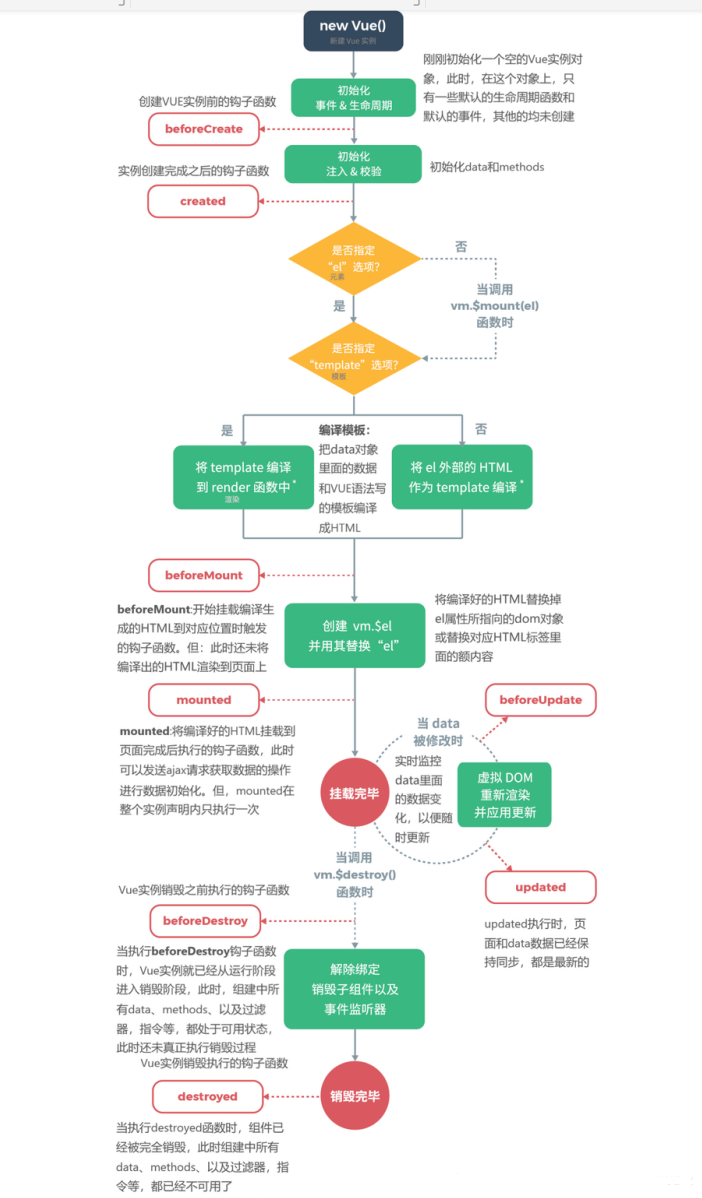
vm的一生(vm的生命周期):
- 将要创建–>调用beforeCreate函数。
- 创建完毕–>调用created函数。
- 将要挂载–>调用beforeMount函数。
- 挂载完毕**(重要)**–>调用mounted函数。------>【重要的钩子】
- 将要更新–>调用beforeUpdate函数。
- 更新完毕–>调用updated函数。
- 将要销毁**(重要)**–>调用beforeDestroy函数。------>【重要的钩子】
- 销毁完毕–>调用destroyed函数。
常用的生命周期钩子:
- mounted:发送ajax请求、启动定时器、绑定自定义事件、订阅消息等【初始化操作】。
- beforeDestroy:清除定时器、解绑自定义事件、取消订阅消息等【收尾工作】。
关于销毁Vue实例
- 销毁后借助Vue开发者工具看不到任何信息。
- 销毁后自定义事件会失效,但原生DOM事件依然有效。
- 一般不会在beforeDestroy操作数据,因为即便操作数据,也不会再触发更新流程了。
<!DOCTYPE html>
<html lang="en">
<head>
<meta charset="UTF-8">
<meta http-equiv="X-UA-Compatible" content="IE=edge">
<meta name="viewport" content="width=device-width, initial-scale=1.0">
<title>helloworld</title>
<script src="js/vue.js"></script>
</head>
<body>
<div id="app">
<p>n的值是:{{n}}</p>
<button @click="add">n+1</button>
<button @click="destroy">点我销毁</button>
</div>
</body>
<script type="text/javascript">
Vue.config.devtools = true //使用VueTools工具进行调试
Vue.config.productionTip=false //以阻止 vue 在启动时生成生产提示
const vm = new Vue({
el:"#app",
data:{
n:1
},
methods:{
add(){
this.n++
},
destroy(){
this.$destroy()
}
},
beforeCreate() {
//此时data还未做数据带来,无法操作data和method等
console.log("beforeCreate")
},
created() {
console.log("beforeCreate")
},
beforeMount() {
console.log("beforeMount")
},
mounted() {
console.log("mounted")
},
beforeUpdate() {
console.log("beforeUpdate")
},
updated() {
console.log("updated")
},
beforeDestroy() {
console.log("beforeDestroy")
},
destroyed() {
console.log("destroyed")
},
})
</script>
</html>
2. Vue组件化编程
2.1 模块与组件,模块化与组件化
2.1.1 模块
- 理解:向外提供特定功能的js程序,一般就是一个js文件
- 为什么:js文件很多很复杂
- 作用:复用js,简化js的编写,提高js运行效率
2.1.2 组件
- 理解:用来实现局部(特定)功能效果的代码集合(html/css/js/image…))
- 为什么:一个界面的功能很复杂
- 作用:复用编码,简化项目编码,提高运行效率
2.1.43 模块化
- 当应用中的js都以模块来编写的,那这个应用就是一个模块化的应用。
2.1.4 组件化
- 当应用中的功能都是多组件的方式来编写的,那这个应用就是一个组件化的应用
2.2 非单文件组件
<!DOCTYPE html>
<html lang="en">
<head>
<meta charset="UTF-8">
<meta http-equiv="X-UA-Compatible" content="IE=edge">
<meta name="viewport" content="width=device-width, initial-scale=1.0">
<title>helloworld</title>
<script src="js/vue.js"></script>
</head>
<body>
<div id="app">
<!--第三步:使用组件-->
<hello></hello>
<hr>
<student></student>
<hr>
<school></school>
</div>
<div id="app2">
<hello></hello>
</div>
</body>
<script type="text/javascript">
Vue.config.devtools = true //使用VueTools工具进行调试
Vue.config.productionTip=false //以阻止 vue 在启动时生成生产提示
//第一步:创建学生组件
const student = Vue.extend({
template:`
<div>
<p>学生姓名:{{sudentName}}</p>
<p>学生年龄:{{age}}</p>
<button @click="ageAdd">年龄+1</button>
</div>
`,
data(){
return {
sudentName:"Lyx",
age: 23
}
},
methods: {
ageAdd(){
this.age ++
}
},
})
//第一步:创建学校组件
const school = Vue.extend({
template:`
<div>
<p>学校名称:{{schoolName}}</p>
<p>学校地址:{{address}}</p>
</div>
`,
data(){
return {
schoolName:"Lyx",
address: "武汉"
}
}
})
//第一步:创建学校组件
const hello = Vue.extend({
template:`
<div>
<p>{{hello}}</p>
</div>
`,
data(){
return {
hello:"hello vue!"
}
}
})
//第二步:注册组件(全局)
Vue.component("hello", hello)
const vm = new Vue({
el:"#app",
components:{ //第二步:注册组件(局部)
student, //student ==》 xuesheng:student
school,
hello
}
})
new Vue({
el:"#app2"
})
</script>
</html>
2.3 使用组件的注意点
几个注意点:
-
关于组件名:
-
一个单词组成:
- 第一种写法(首字母小写): school
- 第二种写法(首字母大写): School
-
多个单词组成:
- 第一种写法(kebab-case命名):my-school
- 第二种写法(Came1Case命名):MySchool(需要Vue脚手架支持)
-
备注:
- 组件名尽可能回避HTML中已有的元素名称,例如:h2、H2都不行。
- 可以使用name配置项指定组件在开发者工具中呈现的名字。
-
-
关于组件标签:
-
第一种写法:
<school>/school> -
第二种写法:
<school/>备注:不用使用脚手架时,会导致后续组件不能渲染。
-
-
一个简写方式:
- const school = Vue.extend(options) 可简写为:const school=options
<!DOCTYPE html>
<html lang="en">
<head>
<meta charset="UTF-8">
<meta http-equiv="X-UA-Compatible" content="IE=edge">
<meta name="viewport" content="width=device-width, initial-scale=1.0">
<title>helloworld</title>
<script src="js/vue.js"></script>
</head>
<body>
<div id="app">
<school></school>
<School></School>
<my-school></my-school>
<say></say>
</div>
</body>
<script type="text/javascript">
Vue.config.devtools = true //使用VueTools工具进行调试
Vue.config.productionTip=false //以阻止 vue 在启动时生成生产提示
const s = Vue.extend({
template:`
<div>
<div>{{address}}</div>
<div>{{schoolName}}</div>
</div>
`,
data(){
return{
schoolName:"武汉东湖学院",
address:"武汉"
}
}
})
const s2 = {
name:"hello",
template:`
<div>
<div>{{say}}</div>
</div>
`,
data(){
return{
say:"hello world"
}
}
}
const vm = new Vue({
el:"#app",
components:{
school:s,
School:s,
'my-school':s,
say:s2
}
})
</script>
</html>
2.4 嵌套组件
<!DOCTYPE html>
<html lang="en">
<head>
<meta charset="UTF-8">
<meta http-equiv="X-UA-Compatible" content="IE=edge">
<meta name="viewport" content="width=device-width, initial-scale=1.0">
<title>helloworld</title>
<script src="js/vue.js"></script>
</head>
<body>
<div id="root">
<app></app>
</div>
<div id="root2">
</div>
</body>
<script type="text/javascript">
Vue.config.devtools = true //使用VueTools工具进行调试
Vue.config.productionTip=false //以阻止 vue 在启动时生成生产提示
//定义学生组件
const student ={
template:`
<div>
<h1>{{studentName}}</h1>
<h2>{{age}}</h2>
</div>
`,
data(){
return{
studentName:"张三",
age:20
}
}
}
//定义老师组件
const teacher ={
template:`
<div>
<h1>{{teacherName}}</h1>
<h2>{{grade}}</h2>
</div>
`,
data(){
return{
teacherName:"罗翔",
grade:"高级"
}
}
}
//定义学校组件
const school ={
template:`
<div>
<h1>{{schoolName}}</h1>
<h2>{{address}}</h2>
<hr>
<teacher></teacher>
<hr>
<student></student>
</div>
`,
data(){
return{
schoolName:"武汉东湖学院",
address:"武汉"
}
},
components:{
student,
teacher
}
}
//定义hello组件
const hello ={
template:`
<div>
<h1>{{hello}}</h1>
</div>
`,
data(){
return{
hello:"welcome to vue!"
}
}
}
//定义app组件统一管理嵌套的组件
const app ={
template:`
<div>
<hello></hello>
<school></school>
</div>
`,
components:{
hello,
school
}
}
const vm = new Vue({
el:"#root",
components:{app}
})
const vm2 = new Vue({
template:`
<app></app>
`,
el:"#root2",
components:{app}
})
</script>
</html>
2.5 VueComponent
关于VueComponent:
- school组件本质是一个名为VueComponent的构造函数,且不是程序员定义的,是Vue.extend生成的。
- 我们只需要写或/school>,Vue解析时会帮我们创建school组件的实例对象,即Vue帮我们执行的:new VueComponent(options)。
- 特别注意:每次调用Vue.extend,返回的都是一个全新的VueComponent!!!
- 关于this指向:
- 组件配置中:
data函数、methods中的函数、watch中的函数、computed中的函数它们的this均是**【VueComponent实例对象】** - new Vue()配置中:
data函数、methods中的函数、watch中的函数、computed中的函数它们的this均是**【Vue实例对象】。**
- 组件配置中:
- VueComponent的实例对象,以后简称vc(也可称之为:组件实例对象)。
Vue的实例对象,以后简称vm。
- 一个重要的内置关系: VueComponent.prototype.__ proto __ == Vue.prototype
- 为什么要有这个关系:让组件实例对象(vc)可以访问到vue原型上的属性、方法
<!DOCTYPE html>
<html lang="en">
<head>
<meta charset="UTF-8">
<meta http-equiv="X-UA-Compatible" content="IE=edge">
<meta name="viewport" content="width=device-width, initial-scale=1.0">
<title>helloworld</title>
<script src="js/vue.js"></script>
</head>
<body>
<div id="root">
<school></school>
</div>
</body>
<script type="text/javascript">
Vue.config.devtools = true //使用VueTools工具进行调试
Vue.config.productionTip=false //以阻止 vue 在启动时生成生产提示
Vue.prototype.n=99
const school = {
template:`
<div>
<h1 v-if="flag">n的值为:{{n}}</h1>
<button @click="show">显示n</button>
</div>
`,
data(){
return{
flag:false
}
},
methods: {
show(){
this.flag =true
}
},
}
const vm = new Vue({
el:"#root",
data:{},
components:{school}
})
</script>
</html>
2.6 单文件组件
-
School.vue
<template> <div> <h1>学校名称:{{name}}</h1> <h2>学校地址:{{address}}</h2> <hr> </div> </template> <script> export default { name:"School", data() { return { name:"武汉东湖", address:"武汉" } }, } </script> <style> </style> -
Student.vue
<template> <div> <h1>学生姓名:{{name}}</h1> <h2>学生年龄:{{age}}</h2> <hr> </div> </template> <script> export default { name:"School", data() { return { name:"张三", age:"19" } }, } </script> <style> </style> -
App.vue
<template> <div> </div> </template> <script> import School from "./School.vue" import Student from "./Student.vue" export default { name:"App", components:{ School, Student } } </script> <style> </style> -
main.js
import App from "./App.vue" new Vue({ el:"#root", template:` <App></App> `, components:{App} }) -
index.html
<!DOCTYPE html> <html lang="en"> <head> <meta charset="UTF-8"> <meta http-equiv="X-UA-Compatible" content="IE=edge"> <meta name="viewport" content="width=device-width, initial-scale=1.0"> <title>Document</title> </head> <body> <div id="root"></div> <script type="text/javascript" src="../js/vue.js"></script> <script type="text/javascript" src="./main.js"></script> </body> </html>
2.7 初始化脚手架
-
安装最新版的CLI
npm install -g @vue/cli # OR yarn global add @vue/cli如果网络很慢使用npm的淘宝镜像的加速
npm config set registry https://registry.npm.taobao.org -
创建项目
切换到你需要的目录下创建一个新项目
vue create xxx你会被提示选取一个 preset。你可以选默认的包含了基本的 Babel + ESLint 设置的 preset,也可以选“手动选择特性”来选取需要的特性。

这个默认的设置非常适合快速创建一个新项目的原型,而手动设置则提供了更多的选项,它们是面向生产的项目更加需要的。
-
运行项目
进入到项目的目录下,运行项目
npm run serve启动成功后出现如下界面
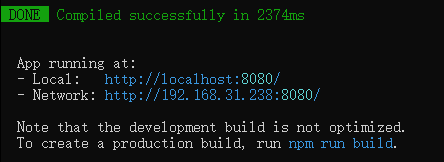
-
测试访问
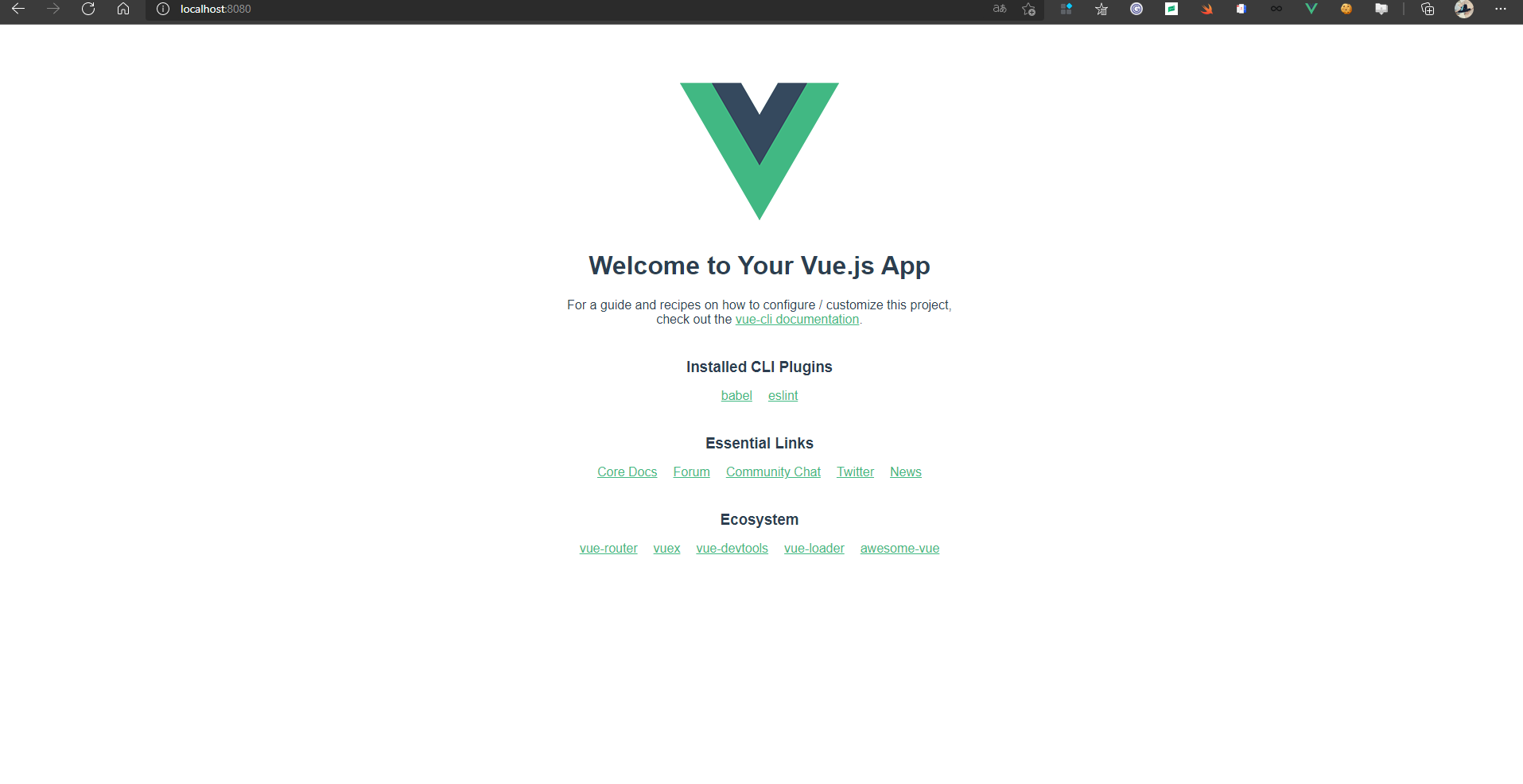
2.8 分析脚手架
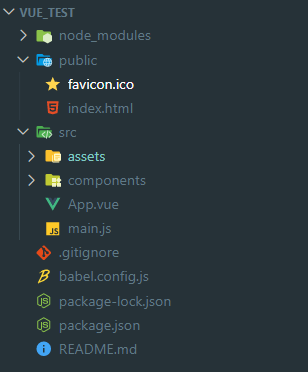
-
node_modules:用于存放我们项目的各种依赖; -
public:用于存放静态资源(不会变动的);-
public/index.html:模板文件,作用是生成项目的入口文件。浏览器访问项目的时候就会默认打开的是生成好的 index.html。<!DOCTYPE html> <html lang=""> <head> <meta charset="utf-8"> <!-- 针对IE浏览器的一个特殊配置,含义是让IE浏览器以最高的渲染级别渲染页面 --> <meta http-equiv="X-UA-Compatible" content="IE=edge"> <!-- 开启移动端理想视口 --> <meta name="viewport" content="width=device-width,initial-scale=1.0"> <!-- 网站图标,<%= BASE_URL %>相当于指定网站根目录 --> <link rel="icon" href="<%= BASE_URL %>favicon.ico"> <!-- 网站标题 --> <title><%= htmlWebpackPlugin.options.title %></title> </head> <body> <!-- 不支持javascript会输出下面这句话 --> <noscript> <strong>We're sorry but <%= htmlWebpackPlugin.options.title %> doesn't work properly without JavaScript enabled. Please enable it to continue.</strong> </noscript> <div id="app"></div> <!-- built files will be auto injected --> </body> </html> -
public/favicon.ico:网站图标
-
-
src:是存放各种 .vue 文件的地方。src/assets:用于存放着各种静态文件(可能会变动),比如图片。src/components:存放公共组件(可复用),比如 header.vue、footer.vue 等。src/App.vue:App.vue 是项目的主组件;App.vue 中使用 router-link 引入其他模块,所有的页面都是在 App.vue 下切换的。src/main.js:入口文件,主要作用是初始化 vue 实例,同时可以在此文件中引用某些组件库或者全局挂载一些变量。
-
.gitignore:配置 git 上传想要忽略的文件格式。 -
babel.config.js:一个工具链,主要用于在当前和较旧的浏览器或环境中将 ES6 的代码转换向后兼容(低版本ES)。 -
package.json:模块基本信息项目开发所需要的模块,版本,项目名称。 -
package-lock.json:是在 npm install 时候生成的一份文件,用于记录当前状态下实际安装的各个 npm package 的具体来源和版本号。
2.18.1 关于不同版本的vue:
wue.js与vue.runtime.xxx.js的区别:- wue.js是完整版的vue,包含:核心功能+模板解析器
- vue.runtime.xxx.js是运行版的vue,只包含核心功能,没有模板解析器
- 因为vue.runtime.xxx,js没有模板解析器,所以不能使用 template配置项,需要使用render函数接收到的 createElementi函数去指定具体内容
2.9 ref属性
-
被用来给元素或子组件注册引用信息(id的替代者
-
应用在htm标签上获取的是真实DM元素,应用在组件标签上是组件实例对象(vc
-
使用方式
- 打标识:
…
或< School ref=“xxx”></ Schoo1> - 获取: this.$refs.xxx
<template> <div> <School ref="sch"></School> <button ref="btn" @click="showDom">button</button> </div> </template> <script> import School from "./components/School.vue" export default { name:"App", components:{School}, methods: { showDom(){ console.log(this.$refs.sch) console.log(this.$refs.btn) } }, } </script> <style> </style> - 打标识:
2.10 配置项props
功能: 让组件接收外部传过来的数据
-
传递数据:
-
接收数据:
-
第一种方式(只接收)
props:[“name”] -
第二种方式(限制类型)
props:{ name: Number } -
第三种方式(限制类型、限制必要性、指定默认值)
props:{ name:{ type: String,//类型 required:true,//必要性 default:'老王'//默认值 } }
-
备注: props是只读的,Wue底层会监测你对 props的修改,如果进行了修改,就会发出警告若业务需求确实需要修改,那么请复制 props的内容到data中一份,然后去修改data中的数据。
<template>
<div>
<School :studentNumber="studentNumber" :tuition="tuition"></School>
</div>
</template>
<script>
import School from "./components/School.vue"
export default {
name:"App",
components:{School},
data() {
return {
studentNumber: 20000,
tuition: 30000
}
},
}
</script>
<style>
</style>
<template>
<div>
<h1>学习名称:{{name}}</h1>
<h2>地址:{{address}}</h2>
<h2>学生人数:{{studentNumber}}</h2>
<h2>学费:{{tuition}}</h2>
</div>
</template>
<script>
export default {
name:"School",
data() {
return {
name:"武汉东湖学院",
address:"湖北武汉"
}
},
//第一种:简单接收数据
// props:["studentNumber","tuition"]
//第二种:接收数据并指定类型
// props:{
// studentNumber: Number,
// tuition: Number
// }
//第三种:接收参数并指定详细内容
props:{
studentNumber:{
type: Number,
required: true,
},
tuition:{
type: Number,
default: 25000,
}
}
}
</script>
<style>
</style>
2.11 mixin(混入)
功能:可以把说个组件共用的配置提取成一个混入对象
使用方式:
-
第一步定义混合,例如:
export const a = { data(){...}, method(){...}, ... } -
第二步使用混入,例如:
-
全局混入
Vue.mixin(组件名) -
局部混入
mixins:[组件名]
-
-
mixin.js
export const mixin = { methods: { showName(){ alert(this.name) } }, } export const mixin2 = { mounted() { console.log("hello vue!") }, data(){ return{ x: 100, y: 200 } } } -
main.js
import Vue from 'vue' import App from './App.vue' import {mixin2} from "./mixin" Vue.config.productionTip = false //定义全局混合组件 Vue.mixin(mixin2) new Vue({ render: h => h(App), }).$mount('#app') -
Student.vue
<template> <div> <h1 @click="showName">学生姓名:{{name}}</h1> <h2>年龄:{{age}}</h2> <h3>x:{{x}}; y:{{y}}</h3> </div> </template> <script> //引入一个混合组件 import {mixin} from "../mixin" export default { name:"Student", data() { return { name:"pony", age:22 } }, mixins:[mixin] } </script> <style> </style> -
School.vue
<template> <div> <h1 @click="showName">学习名称:{{name}}</h1> <h2>地址:{{address}}</h2> <h3>x:{{x}}; y:{{y}}</h3> </div> </template> <script> //引入一个混合组件 import {mixin} from "../mixin" export default { name:"School", data() { return { name:"武汉东湖学院", address:"湖北武汉", x: 200 //与混合组件中有相同的属性以自己的为准 } }, mixins:[mixin] } </script> <style> </style>
2.12 插件
功能: 用于增强Vue
本质: 包含 insta11方法的一个对象, insta11的第一个参数是vue,第二个以后的参数是插件使用者传递的数
定义插件:
对象. insta11= function(vue, options){
//1.添加全局过滤器
Vue filter(...)
//2.添加全局指令
Vue.directive(...)
//3.配置全局混入(合)
Vue mixin (...)
//4.添加实例方法
Vue.prototype.$myMethod=function(){}
Vue.prototype.$myProperty=xxx
}
使用插件: Vue.use()
快速体验:
export default {
install(Vue){
// console.log("@@@install",Vue)
//全局的filter
Vue.filter("mySlice", function(value){
return value.slice(0,4)
})
//全局自定义指令
Vue.directive("fbind",{
bind(element, binding){ //指令与元素成功绑定时调用
console.log("bind")
element.value = binding.value*10
},
inserted(element){ //指令所在元素被插入页面后调用
console.log("inserted")
element.focus()
},
update(element, binding){ //指令所用到的数据发生更新时调用
console.log("update")
element.value = binding.value*10
}
})
//全局混入
Vue.mixin({
data(){
return{
x: 20,
y: 30
}
}
})
}
}
import plugins from "./plugins"
Vue.use(plugins)
2.13 scoped样式
每个模块里面定义的样式默认都是全局使用的,在app里面后引入的模块样式会覆盖掉先引入的样式,只需要在style标签里定义scoped属性即可定义局部的style样式,只在模块内生效。
<style scoped>
.demo{
background-color: skyblue;
}
</style>
2.14 TodoList案例
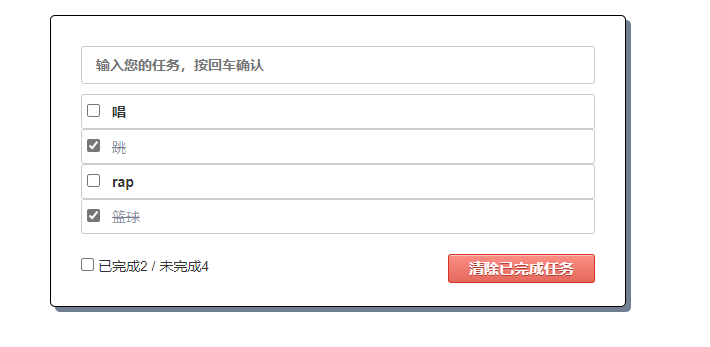
-
组件化编码流程:
- 拆分静态组件: 组件要按照功能点拆分,命名不要与hm元素冲突。
- 实现动态组件: 考虑好数据的存放位置,数据是一个组件在用,还是些组件在用
- 一个组件在用: 放在组件自身即可。
- 一些组件在用: 放在他们共同的父组件上(状态提升)
- 实现交互: 从绑定事件开始。
-
props适用于
- 父组件 => 子组件通信
- 子组件 => 父组件通信(要求父先给子一个函数)
- 使用 v-mode时要切记: v-mode绑定的值不能是 props传过来的值,因为 props是不可以修改的
- props传过来的若是对象类型的值,修改对象中的属性时vue不会报错,但不推荐这样做。
2.14.1 App.Vue
<template>
<div id="main">
<FormTop :addTodo="addTodo"/>
<FormList
:todos="todos"
:checkTodo="checkTodo"
:deleteTodo="deleteTodo"/>
<FormFooter
:todos="todos"
:checkAllTodo="checkAllTodo"
:deleteDoneTodo="deleteDoneTodo"/>
</div>
</template>
<script>
import FormTop from "./components/FormTop.vue"
import FormList from "./components/FormList.vue"
import FormFooter from "./components/FormFooter.vue"
export default {
name:"App",
components:{FormTop,FormList,FormFooter},
data(){
return{
todos:[
{id:"001", name:"唱", done: false },
{id:"002", name:"跳", done: true },
{id:"003", name:"rap", done: false },
{id:"004", name:"篮球", done: true },
]
}
},
methods:{
//添加一个todo
addTodo(todoObj){
this.todos.unshift(todoObj)
},
//勾选或取消勾选任务
checkTodo(id){
this.todos.forEach((todo)=>{
if(todo.id === id) todo.done = !todo.done
})
},
//删除任务
deleteTodo(id){
this.todos = this.todos.filter(todo => todo.id !== id )
},
//勾选或者取消全部
checkAllTodo(done){
this.todos.forEach(todo => todo.done = done)
},
//删除已完成任务
deleteDoneTodo(){
if(confirm("确定删除?"))
this.todos = this.todos.filter(todo => !todo.done)
}
}
}
</script>
<style>
input{
margin: 0px;
}
*{margin:0px;padding:0px}
#main{
border:1px solid #000;
border-radius: 5px;
box-shadow: slategray 5px 5px;
width: 30%;
margin: 0 auto;
}
#main{
margin-top: 30px;
padding: 30px;
}
</style>
2.14.2 FormTop.vue
<template>
<div id="top">
<input type="text" id="input" v-model="inputText" @keyup.enter="add" placeholder="输入您的任务,按回车确认"/>
</div>
</template>
<script>
import {nanoid} from "nanoid"
export default {
neme:"FormTop",
data(){
return{
inputText:""
}
},
props:["addTodo"],
methods:{
add(){
//校验输入框是否为空
if(!this.inputText.trim()) return alert("输入不能为空!")
//输入框不为空创建todo对象
const todoObj = {
id: nanoid(), //使用nanoid生成id
name: this.inputText,
done: false
}
//传入数据添加到todos中
this.addTodo(todoObj)
this.inputText=""
}
},
}
</script>
<style scoped>
#top{
margin-bottom: 10px;
}
#input{
outline-style: none ;
border: 1px solid #ccc;
border-radius: 3px;
padding: 8px 14px;
width: 100%;
font-size: 14px;
font-weight: 700;
font-family: "Microsoft soft";
}
#input:focus{
border-color: #66afe9;
outline: 0;
-webkit-box-shadow: inset 0 1px 1px rgba(0,0,0,.075),0 0 8px rgba(102,175,233,.6);
box-shadow: inset 0 1px 1px rgba(0,0,0,.075),0 0 8px rgba(102,175,233,.6)
}
</style>
2.14.3 FormList.vue
<template>
<ul id="list">
<FormListItem
v-for="todo in todos"
:key="todo.id"
:todo="todo"
:checkTodo="checkTodo"
:deleteTodo="deleteTodo"/>
<li v-show="!todos.length" :style="noTask">暂无任务,请添加!</li>
</ul>
</template>
<script>
import FormListItem from "./FormListItem.vue"
export default {
neme:"FormList",
components:{FormListItem},
data(){
return{
noTask:{
listStyle: "none",
color: "red",
textAlign: "center",
fontSize: "20px",
fontWeight: "600",
marginTop: "20px"
}
}
},
props:["todos", "checkTodo", "deleteTodo"]
}
</script>
<style>
</style>
2.14.4 FormListItem.vue
<template>
<li>
<input type="checkbox"
:checked="todo.done"
@change="check(todo.id)"><span class="text" :style="isDone(todo.done)" @click="showInfo(todo)">{{todo.name | mySlice}}</span>
<span><a href="#" @click="todoDelete(todo.id)">×</a></span>
</li>
</template>
<script>
export default {
neme:"FormListItem",
props:["todo", "checkTodo", "deleteTodo"],
methods:{
check(id){
this.checkTodo(id)
},
todoDelete(id){
if(confirm("确定删除?")){
this.deleteTodo(id)
}
},
isDone(done){
const doneStyle = {
color: "slategray",
fontWeight: "200",
textDecoration:"line-through"
}
if(done)
return doneStyle
},
showInfo(todo){
alert("任务名:"+ todo.name + "\r\n\n完成情况:"+ (todo.done ? "完成":"未完成"))
}
},
filters:{
mySlice(value){
return value.slice(0,15) + (value.length > 15 ? "...":"")
}
}
}
</script>
<style scoped>
li{
list-style: none;
border: 1px solid #ccc;
width: 100%;
height: 35px;
line-height: 33px;
border-radius: 3px;
padding: 1px 5px;
}
li span:last-child{
display: none;
float: right;
margin-right: 10px;
font-size: 28px;
font-weight: 100;
}
li:hover{
background-color:silver;
}
li:hover span:last-child{
display: block;
}
.text{
font-size: 14px;
font-weight: 600;
margin-left: 12px;
}
a{
text-decoration: none;
color:seashell;
}
a:hover{
color: red;
}
</style>
2.14.5 FormFooter.vue
<template>
<div id="footer" v-show="count">
<input type="checkbox" v-model="isAllCheck"> <span>已完成{{doneCount}} / 未完成{{count}}</span> <input class="myButton" type="button" @click="deleteDoneTodo" value="清除已完成任务">
</div>
</template>
<script>
export default {
neme:"FormFooter",
props:["todos", "checkAllTodo", "deleteDoneTodo"],
computed:{
count(){
return this.todos.length
},
doneCount(){
return this.todos.reduce((pre,todo) => pre+(todo.done ? 1 : 0), /*初始值*/0)
},
isAllCheck:{
get(){
return this.count === this.doneCount && this.count !== 0
},
set(value){
this.checkAllTodo(value)
}
}
}
}
</script>
<style scoped>
#footer{
margin: 20px 0px 0px 0px;
}
.myButton {
box-shadow:inset 0px 1px 0px 0px #f7c5c0;
background:linear-gradient(to bottom, #fc8d83 5%, #e4685d 100%);
background-color:#fc8d83;
border-radius:3px;
border:1px solid #d83526;
cursor:pointer;
color:#ffffff;
font-family:Arial;
font-size:15px;
font-weight:bold;
padding:3px 20px;
text-decoration:none;
text-shadow:0px 1px 0px #b23e35;
float: right;
}
.myButton:hover {
background:linear-gradient(to bottom, #e4685d 5%, #fc8d83 100%);
background-color:#e4685d;
}
.myButton:active {
position:relative;
top:1px;
}
</style>
2.15 webStorage
- 存储内容大小一般支持5MB左右(不同浏览器可能还不一样)
- 浏览器端通过 Window. sessionStorage和 Window.localStorage属性来实现本地存储机制。
- 相关API
xxxxxStorage.setItem('key','value')
该方法接受—个键和值作为参数,会把键值对添加到存储中,如果键名存在,则更新其对应的值。xxxxxStorage.getItem('person')
该方法接受一个键名作为参数,返回键名对应的值。xxxxxStorage.removeItem('key')
该方法接受—个键名作为参数,并把该键名从存储中删除。xxxxxStorage.clear()
该方法会清空存储中的所有数据
- 备注
- sessionStorage存储的内容会随着浏览器窗口关闭而消失
- localStorage存储的内容,需要手动清除才会消失
- xxxxxStorage.getItem(x)如果x对应的vae获取不到,那么 getter的返回值是null
- JSON. parse(null)的结果依然是null
2.15.1 localStorage
<!DOCTYPE html>
<html lang="en">
<head>
<meta charset="UTF-8">
<meta http-equiv="X-UA-Compatible" content="IE=edge">
<meta name="viewport" content="width=device-width, initial-scale=1.0">
<title>localStroage</title>
</head>
<body>
<h1>localStorage</h1>
<button onclick="add()">添加stroage</button>
<button onclick="deleteOne()">删除一个stroage</button>
<button onclick="get()">得到stroage</button>
<button onclick="deleteAll()">清空stroage</button>
<script type="text/javascript">
function add(){
localStorage.setItem("msg", "hello world!")
const person = {"id": "001", "name": "张三", "age": 18}
localStorage.setItem("pserson", JSON.stringify(person))
}
function deleteOne(){
localStorage.removeItem("msg")
}
function get(){
console.log("msg", localStorage.getItem("msg"))
console.log("person", JSON.parse(localStorage.getItem("msg")))
}
function deleteAll(){
localStorage.clear()
}
</script>
</body>
</html>
2.15.2 SessionStorage
<!DOCTYPE html>
<html lang="en">
<head>
<meta charset="UTF-8">
<meta http-equiv="X-UA-Compatible" content="IE=edge">
<meta name="viewport" content="width=device-width, initial-scale=1.0">
<title>sessionStroage</title>
</head>
<body>
<h1>sessionStorage</h1>
<button onclick="add()">添加stroage</button>
<button onclick="deleteOne()">删除一个stroage</button>
<button onclick="get()">得到stroage</button>
<button onclick="deleteAll()">清空stroage</button>
<script type="text/javascript">
function add(){
sessionStorage.setItem("msg", "hello world!")
const person = {"id": "001", "name": "张三", "age": 18}
sessionStorage.setItem("pserson", JSON.stringify(person))
}
function deleteOne(){
sessionStorage.removeItem("msg")
}
function get(){
console.log("msg", sessionStorage.getItem("msg"))
console.log("person", JSON.parse(sessionStorage.getItem("msg")))
}
function deleteAll(){
sessionStorage.clear()
}
</script>
</body>
</html>
2.16 本地存储TodoList案例
使用js原生自带的localStorage属性,仅修改App.vue即可,其他的组件使用上面案例即可!
<template>
<div id="main">
<FormTop :addTodo="addTodo"/>
<FormList
:todos="todos"
:checkTodo="checkTodo"
:deleteTodo="deleteTodo"/>
<FormFooter
:todos="todos"
:checkAllTodo="checkAllTodo"
:deleteDoneTodo="deleteDoneTodo"/>
</div>
</template>
<script>
import FormTop from "./components/FormTop.vue"
import FormList from "./components/FormList.vue"
import FormFooter from "./components/FormFooter.vue"
export default {
name:"App",
components:{FormTop,FormList,FormFooter},
data(){
return{
// todos:[
// {id:"001", name:"唱", done: false },
// {id:"002", name:"跳", done: true },
// {id:"003", name:"rap", done: false },
// {id:"004", name:"篮球", done: true },
// ]
todos: JSON.parse(localStorage.getItem("todos")) || []
}
},
methods:{
//添加一个todo
addTodo(todoObj){
this.todos.unshift(todoObj)
},
//勾选或取消勾选任务
checkTodo(id){
this.todos.forEach((todo)=>{
if(todo.id === id) todo.done = !todo.done
})
},
//删除任务
deleteTodo(id){
this.todos = this.todos.filter(todo => todo.id !== id )
},
//勾选或者取消全部
checkAllTodo(done){
this.todos.forEach(todo => todo.done = done)
},
//删除已完成任务
deleteDoneTodo(){
if(confirm("确定删除?"))
this.todos = this.todos.filter(todo => !todo.done)
}
},
watch:{
todos:{
deep:true, //开启深度监视
handler(value){
localStorage.setItem("todos", JSON.stringify(value))
}
}
}
}
</script>
<style>
input{
margin: 0px;
}
*{margin:0px;padding:0px}
#main{
border:1px solid #000;
border-radius: 5px;
box-shadow: slategray 5px 5px;
width: 30%;
margin: 0 auto;
}
#main{
margin-top: 30px;
padding: 30px;
}
</style>
2.17 自定义事件
-
一种组件间通信的方式,适用于:子组件=>父组件
-
使用场景 :A是父组件, B是子组件, B想给A传数据, 那么就要在A中给B绑定自定义事件(事件的回调在A中)
-
绑定自定义事件
-
第一种方式,在父组件中: <Demo @atguigu=“test”/>或< Demo v-on:atguigu=“test”/>
-
第二种方式,在父组件中
<Demo ref="demo"/> ...... mounted(){ this.$refs.xxx.$on("事件名", this.绑定的回调函数) } -
若想让自定义事件只能触发一次,可以使用
once修饰符,或$once方法
-
-
触发自定义事件:this.
$emit("事件名', 传入的参数) -
解绑自定义事件
this.$???off('事件名') -
组件上也可以绑定原生DOM事件,需要使用 native修饰符。
2.17.1 绑定自定义事件
<template>
<div>
<!-- 通过父组件给子组件传递函数类型的 props实现:子给父传递数据 -->
<School :showName="showName"/>
<hr>
<!-- 通过父组件给子组件绑定一个自定义事件实现:子给父传递数据(第一种写法,使用@或v-on) -->
<Student @lyx="showName"/>
<hr>
<!-- 通过父组件给子组件绑定一个自定义事件实现:子给父传递数据(第二种写法,使用ref) -->
<Student ref="stu"/>
</div>
</template>
<script>
import School from "./components/School.vue"
import Student from "./components/Student.vue"
export default {
name:"App",
components:{School,Student},
methods: {
showName(name){
alert(name)
}
},
mounted(){
setTimeout(()=>{ //3秒后绑定事件
this.$refs.stu.$on("lyx", this.showName)
},3000)
}
}
</script>
<style>
</style>
<template>
<div>
<h1 @click="inApp">学生姓名:{{name}}</h1>
<h2>学生年龄:{{address}}</h2>
</div>
</template>
<script>
export default {
name:"Student",
data() {
return {
name:"张三",
address:18
}
},
methods:{
inApp(){
this.$emit("lyx", "学生传来消息:"+this.name)
}
}
}
</script>
<style>
</style>
<template>
<div>
<h1 @click="inApp">学校名称:{{name}}</h1>
<h2>学校地址:{{address}}</h2>
</div>
</template>
<script>
export default {
name:"School",
data() {
return {
name:"武汉东湖学院",
address:"湖北武汉"
}
},
props:["showName"],
methods:{
inApp(){
this.showName("学校传来消息:"+this.name)
}
}
}
</script>
<style>
</style>
2.17.2 解绑自定义事件
<template>
<div>
<h1 @click="inApp">学生姓名:{{name}}</h1>
<h2>学生年龄:{{address}}</h2>
<button @click="destruction">销毁自定义事件</button>
<button @click="destructionVC">销毁vc实例</button>
</div>
</template>
<script>
export default {
name:"Student",
data() {
return {
name:"张三",
address:18
}
},
methods:{
inApp(){
this.$emit("lyx", "学生传来消息:"+this.name)
this.$emit("clog")
},
destruction(){
// this.$off("lyx") //销毁一个自定义事件
// this.$off(["lyx","clog"]) //销毁多个自定义事件
this.$off() // 销毁所有的自定义事件
},
destructionVC(){
this.$destroy() //销毁实例对象,自定义事件都销毁了
}
}
}
</script>
<style>
</style>
2.18 全局事件总线(G| obalEventBus)
-
—种组件间通信的方式,适用于任意组件间通信。
-
安装全局事件总线
new Vue({ ...... beforeCreate(){ Vue.prototype.$bus = this // 安装全局事件总线,$bus就是当前应用的vm }, ...... }) -
使用事件总线
-
接收数据: A组件想接收数据,则在A组件中给$bus绑定自定义事件,事件的回调留在A组件自身
methods:{ demo(data){......} }, mounted(){ this.$bus.$on("xxx", this.demo) } -
提供数据:
this.$bus.$emit("xxx", 数据)
-
-
最好在 beforeDestroy钩子中,用$off去解绑当前组件所用到的事件。
快速体验:
-
main.js
import Vue from 'vue' import App from './App.vue' Vue.config.productionTip = false new Vue({ render: h => h(App), beforeCreate(){ Vue.prototype.$bus = this // 安装全局事件总线 } }).$mount('#app') -
School.vue
<template> <div> <h1>学习名称:{{name}}</h1> <h2>地址:{{address}}</h2> </div> </template> <script> export default { name:"School", data() { return { name:"武汉东湖学院", address:"湖北武汉", } }, mounted(){ this.$bus.$on("sendName", (name)=>{ //在总线上创建自定义事件用于接收数据 alert("School收到学生姓名:"+name); }) }, beforeDestroy(){ this.$bus.$off("sendName") //生命周期结束,销毁自定义事件 } } </script> <style> </style> -
Student.vue
<template> <div> <h1>学生姓名:{{name}}</h1> <h2>年龄:{{age}}</h2> <button @click="sendName">sendName</button> </div> </template> <script> export default { name:"Student", data() { return { name:"pony", age:22 } }, methods:{ sendName(){ this.$bus.$emit("sendName", this.name) //使用自定义事件传递数据 } } } </script> <style> </style>
2.19 消息订阅与发布( pubsub)
-
种组件间通信的方式,适用于任意组件间通信。
-
使用步骤
-
安装 pubsub:
npm i pubsub-js -
引入:
import pubsub from 'pubsub-js' -
接收数据:A组件想接收数据, 则在A组件中订阅消息, 订阅的回调留在A组件自身。
methods:{ demo(data){...} } ... mounted(){ this.pid = pubsub.subscribe("xxx", this.demo) //订阅消息 } -
提供数据:
pubsub.publish("xxx", 数据) -
最好在beforeDestroy钩子中,使用
pubsub.unsubscribe(pid)去取消订阅
-
快速体验:
-
消息订阅者
<template> <div> <h1>学习名称:{{name}}</h1> <h2>地址:{{address}}</h2> </div> </template> <script> import pubsub from "pubsub-js" export default { name:"School", data() { return { name:"武汉东湖学院", address:"湖北武汉", } }, mounted(){ // this.$bus.$on("sendName", (name)=>{ //在总线上创建自定义事件用于接收数据 // alert("School收到学生姓名:"+name); // }) // this.pid = pubsub.subscribe("hello", (msgName,data)=>{ // alert("学校收到学生姓名:"+data) /}) this.pid = pubsub.subscribe("hello", (_,data)=>{ //使用_站位,表示不使用 alert("学校收到学生姓名:"+data) }) }, beforeDestroy(){ // this.$bus.$off("sendName") //生命周期结束,销毁自定义事件 pubsub.unsubscribe(this.pid) //取消订阅 } } </script> <style> </style> -
消息发布者
<template> <div> <h1>学生姓名:{{name}}</h1> <h2>年龄:{{age}}</h2> <button @click="sendName">sendName</button> </div> </template> <script> import pubsub from "pubsub-js" export default { name:"Student", data() { return { name:"pony", age:22 } }, methods:{ sendName(){ // this.$bus.$emit("sendName", this.name) pubsub.publish("hello", this.name) } } } </script> <style> </style>
2.20 nextTick
- 语法:this.$nextTick(回调函数)
- 作用: 在下一次DOM更新结束后执行其指定的回调。
- 什么时候用: 当改变数据后,要基于更新后的新DOM进行某些操作时,要在 nextTick所指定的回调函数中执行
2.21 Vue封装的过度与动画
-
作用: 在插入、更新或移除DOM元素时,在合适的时候给元素添加样式类名
-
图示
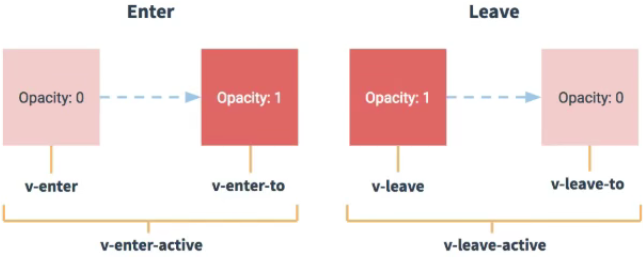
-
写法
-
准备好样式:
- 元素进入的样式
- v- enter: 进入的起点
- V-enter-active: 进入过程中
- v-enter-to: 进入的终点
- 元素离开的样式
- v-leave: 离开的起点
- v-leave-active: 离开的过程
- v-leave-to: 离开的终点
- 元素进入的样式
-
使用
<transition>包裹要过度的元素,并配置name属性<transition name="hello"> <h1 v-show="isShow"> hello vue </h1> </transition> -
备注:若有多个元素需要过度,则需要使用:
< transition- group>, 且每个元素都要指定key值
-
快速体验:
<template>
<div>
<button @click="isShow = !isShow">显示/隐藏</button>
<transition name="h" appear>
<div class="box" v-show="isShow">hello vue!</div>
</transition>
</div>
</template>
<script>
export default {
name:"test",
data(){
return{
isShow:true
}
}
}
</script>
<style>
.box{
margin: 20px 0px;
box-shadow:darkorange 5px 5px;
border:black 1px solid;
border-radius: 5px;
width: 200px;
height: 200px;
padding: 20px;
font-size: 40px;
font-weight: 800;
}
/*自定义动画*/
@keyframes effect {
from{
transform: translateX(-100%);
}
to{
transform: translateX(0px);
}
}
/*默认transition没有name,使用v开头,有name就替换掉v*/
.h-enter-active{
animation: effect 1s linear;
}
.h-leave-active{
animation: effect 1s linear reverse;
}
</style>
<template>
<div>
<button @click="isShow = !isShow">显示/隐藏</button>
<transition name="h" appear>
<h1 class="box" v-show="isShow">hello vue!</h1>
</transition>
</div>
</template>
<script>
export default {
name:"test2",
data(){
return{
isShow:true
}
}
}
</script>
<style>
.box{
margin: 20px 0px;
box-shadow:darkorange 5px 5px;
border:black 1px solid;
border-radius: 5px;
width: 200px;
height: 200px;
padding: 20px;
font-size: 40px;
font-weight: 800;
}
/*使用过渡*/
/*进入的起点,离开的终点*/
.h-enter, .h-leave-to{
transform: translateX(-100%);
}
/*进入的终点,离开的起点*/
.h-enter-active, .h-leave-active{
transition: 0.5 linear;
}
/*进入或离开时响应的动画*/
.h-enter-to, .h-leave{
transform: translateX(0);
}
</style>
<template>
<div>
<button @click="isShow = !isShow">显示/隐藏</button>
<transition-group name="h" appear>
<h1 class="box" v-show="!isShow" key="1">hello vue!</h1>
<h1 class="box" v-show="isShow" key="2">hello world!</h1>
</transition-group>
</div>
</template>
<script>
export default {
name:"test3",
data(){
return{
isShow:true
}
}
}
</script>
<style scoped>
.box{
margin: 20px 0px;
box-shadow:darkorange 5px 5px;
border:black 1px solid;
border-radius: 5px;
width: 200px;
height: 200px;
padding: 20px;
font-size: 40px;
font-weight: 800;
}
/*使用过渡*/
/*进入的起点,离开的终点*/
.h-enter, .h-leave-to{
transform: translateX(-100%);
}
/*进入的终点,离开的起点*/
.h-enter-active, .h-leave-active{
transition: 0.5 linear;
}
/*进入或离开时响应的动画*/
.h-enter-to, .h-leave{
transform: translateX(0);
}
</style>
<template>
<div>
<button @click="isShow = !isShow">显示/隐藏</button>
<transition-group
appear
name="animate__animated animate__bounce"
enter-active-class="animate__bounceInDown"
leave-active-class="animate__bounceOutUp">
<h1 class="box" v-show="!isShow" key="1">hello vue 1212!</h1>
<h1 class="box" v-show="isShow" key="2">hello world !</h1>
</transition-group>
</div>
</template>
<script>
import "animate.css"
export default {
name:"test4",
data(){
return{
isShow:true
}
}
}
</script>
<style scoped>
.box{
margin: 20px 0px;
box-shadow:darkorange 5px 5px;
border:black 1px solid;
border-radius: 5px;
width: 200px;
height: 200px;
padding: 20px;
font-size: 40px;
font-weight: 800;
}
</style>
2.22 vue脚手架配置代理
2.22.1 方法一
在 vue.config. js中添加如下配置:
devServer: {
proxy: "被代理服务器的ip:端口"
}
说明
- 优点:配置简单,请求资源时直接发给前端(8080)即可
- 缺点:不能配置多个代理,不能灵活的控制请求是否走代理
- 工作方式:若按照上述配置代理,当请求了前端不存在的资源时,那么该请求会转发给服务器(优先匹配前端资源
2.22.3 方法二
编写vue.config. js 配置具体代理规则:
devServer: {
proxy: {
"/server": {
target: "http://localhost:8001",
pathRewrite: {"^/server": ""}, //将请求头中的字符替换掉
ws: true, //用于支持websocket
changeOrigin: true, //用于支持请求头中的host值
},
"/server2": {
target: "http://localhost:8002",
pathRewrite: {"^/server2": ""}, //将请求头中的字符替换掉
ws: true, //用于支持websocket
changeOrigin: true, //用于支持请求头中的host值
},
}
}
说明
- 优点:可以配置多个代理,且可以灵活的控制请求是否走代理。
- 缺点:配置略微繁琐,请求资源时必须加前缀。
快速体验:
vue.config.js
module.exports = {
pages: {
index: {
entry: "src/main.js",
},
},
lintOnSave: false,
//代理服务器方法一:
// devServer: {
// proxy: "http://localhost:8001"
// }
//代理服务器方法二
devServer: {
proxy: {
"/server": {
target: "http://localhost:8001",
pathRewrite: {"^/server": ""}, //将请求头中的字符替换掉
ws: true, //用于支持websocket
changeOrigin: true, //用于支持请求头中的host值
}
}
}
}
App.vue
<template>
<div>
<button @click="getStudents">得到所有学生信息</button>
</div>
</template>
<script>
import axios from "axios"
export default {
name:"App",
components:{},
methods:{
getStudents(){
axios.get("http://localhost:8080/server/user/getAll").then(
response => {
console.log("请求成功了", response.data)
},
error => {
console.log("请求失败了", error.message)
}
)
}
}
}
</script>
<style>
</style>
2.23 插槽
-
作用:让父组件可以向子组件指定位置插入hm结构,也是一种组件间通信的方式,适用于父组件=>子组件
-
分类:默认插槽、具名插槽、作用域插槽
-
使用方式
-
默认插槽
父组件: <Category> <h1> hello world </h1> </Category> 子组件 <template> <slot>父组件不传入插槽时显示</slot> </template> -
具名插槽
父组件: <Category> <h1 slot:center> hello world! </h1> <p slot:footer> 你好,世界! </p> </Category> 子组件 <template> <slot name="center">父组件不传入插槽时显示</slot> <slot name="footer">父组件不传入插槽时显示</slot> </template> -
作用域插槽
-
理解:数据在组件的自身,但根据数据生成的结构需要组件的使用者来决定。( games据在 Category组件中,但使用数据所遍历出来的结构由App组件决定)
-
具体编码
父组件: <Category> <ul slot-scope="games"> <li v-for="game in games">{{game}}</li> </ul> </Category> 子组件 <template> <slot :games="games">父组件不传入插槽时显示</slot> </template> ... data(){ return{ games: ["穿越火线", "绝地求生", "欢乐斗地主", "魔兽世界"] } } ...
-
-
3 Vuex
-
安装vuex
npm i vuex -
创建store文件夹,并在其中创建index.js文件
//该文件用于创建Vuex中最核心的store //引入Vue import Vue from 'vue' //引入Vuex import Vuex from "vuex" //应用Vuex插件 Vue.use(Vuex) //准备actions-用于响应组件中的动作 const actions = { add(context, value){ console.log("actions.add() 被调用了"); context.commit("ADD", value) }, subtraction(context, value){ console.log("actions.subtraction() 被调用了"); context.commit("SUBTRACTION", value) }, addWait(context, value){ console.log("actions.addWait() 被调用了"); setTimeout(() => { context.commit("ADDWATI", value) }, 3000); }, addOdd(context, value){ console.log("actions.addOdd() 被调用了"); if(context.state.num % 2) context.commit("ADDODD", value) }, } //准备mutations-用于操作数据(state) const mutations = { ADD(state,value){ console.log("mutations.add() 被调用了"); state.num += value }, SUBTRACTION(state,value){ console.log("mutations.subtraction() 被调用了"); state.num -= value }, ADDWATI(state,value){ console.log("mutations.ADDWATI() 被调用了"); state.num += value }, ADDODD(state,value){ console.log("mutations.ADDODD() 被调用了"); state.num += value }, } //准备state-用于存储数据 const state = { num: 99 } //创建并暴露store export default new Vuex.Store({ actions, mutations, state, }) -
main.js中引入vuex
import store from "./store" new Vue({ render: h => h(App), store, }).$mount('#app') -
使用vuex
<template> <div class="container"> <div class="row"> <div class="col-md-offset-4 col-md-4"> <h1 class="text-center">n的值是:<span class="text-danger">{{$store.state.num}}</span></h1> <div class="col-md-3"> <select class="form-control" v-model="selNum"> <option :value="1">1</option> <option :value="2">2</option> <option :value="3">3</option> <option :value="4">4</option> </select> </div> <div class="col-md-9"> <button class="btn btn-success" @click="add">+</button> <button class="btn btn-info" @click="subtraction">-</button> <button class="btn btn-warning" @click="addWait">延时+</button> <button class="btn btn-default" @click="addOdd">奇数+</button> </div> </div> </div> </div> </template> <script> export default { name: "Counter", data(){ return{ selNum: 1 } }, methods:{ add(){ this.$store.dispatch("add", this.selNum) }, subtraction(){ this.$store.dispatch("subtraction", this.selNum) }, addWait(){ this.$store.dispatch("addWait", this.selNum) }, addOdd(){ this.$store.dispatch("addOdd", this.selNum) } } } </script> <style> button{ margin-left: 5px; } </style>
3.1 getters的使用
-
概念:当 state中的数据需要经过加工后再使用时,可以使用 getters加工。
-
在
store.js中追加getters配置const getters = { bigNum(state){ return state.num * 10 } } //创建并暴露store export default new Vuex.Store({ actions, mutations, state, getters }) -
组件中读取:
$store.getters.bigNum
3.2 四个map方法的使用
导入map
import {mapState,mapGetters} from 'vuex'
-
mapState方法: 用于帮助我们映射 state中的数据为计算属性
//借助mapState生成计算属性,从state中读取数据。(对象写法) ...mapState({num:"num", name:"name", address:"address"}), //借助mapState生成计算属性,从state中读取数据。(数组写法) ...mapState(["num","name","address"]), -
mapGetters方法: 用于帮助我们映射 getters中的数据为计算属性
//借助mapGetters生成计算属性,从getters中读取数据。(对象写法) ...mapGetters({bigNum:"bigNum"}), //借助mapGetters生成计算属性,从getters中读取数据。(数组写法) ...mapGetters(["bigNum"]) -
mapActions方法: 用于帮助我们生成与
actions对话的方法,即:包含$store.dispatch(xx)的函数//借助mapActions生成方法。(对象写法) ...mapActions({add:"add", subtraction:"subtraction", addWait:"addWait", addOdd:"addOdd"}), //借助mapActions生成方法。(数组写法) ...mapActions(["add","subtraction","addWait","addOdd"]) -
mapMutations方法: 用于帮助我们生成与
mutations对话的方法,即:包含$store.commit(x)的函数//借助mapMutations生成方法。(对象写法) ...mapMutations({add:"ADD", subtraction:"SUBTRACTION"}), //借助mapMutations生成方法。(数组写法) ...mapMutations(["ADD", "SUBTRACTION"])
3.3 模块化+命名空间
-
目的:让代码更好维护,让多种数据分类更加明确
-
修改
store.jsconst counterOption = { namespaced:true, //开启命名空间 actions:{ add(context, value){ console.log("actions.add() 被调用了"); context.commit("ADD", value) }, subtraction(context, value){ console.log("actions.subtraction() 被调用了"); context.commit("SUBTRACTION", value) }, addWait(context, value){ console.log("actions.addWait() 被调用了"); setTimeout(() => { context.commit("ADDWATI", value) }, 3000); }, addOdd(context, value){ console.log("actions.addOdd() 被调用了"); if(context.state.num % 2) context.commit("ADDODD", value) }, }, mutations:{ ADD(state,value){ console.log("mutations.add() 被调用了"); state.num += value }, SUBTRACTION(state,value){ console.log("mutations.subtraction() 被调用了"); state.num -= value }, ADDWATI(state,value){ console.log("mutations.ADDWATI() 被调用了"); state.num += value }, ADDODD(state,value){ console.log("mutations.ADDODD() 被调用了"); state.num += value }, }, state:{ num: 1, name: "lyx", address: "蕲春", }, getters:{ bigNum(state){ return state.num * 10 } } } const personOption = { namespaced:true, //开启命名空间 actions:{ }, mutations:{ ADD_PERSON(state, value){ console.log("mutations.ADD_PERSON() 被调用了"); state.personList.unshift(value) } }, state:{ personList:[{id:"001",name:"张三"}] }, getters:{ } } //创建并暴露store export default new Vuex.Store({ modules:{ counterAbout:counterOption, personAbout:personOption } }) -
开启命名空间后,组件中读取 state数据
//方式一:直接读取(state后接命名空间,用于区分该state属于哪个模块) this.$store.state.personAbout.personList //方式二:借助mapState ...mapActions("counterAbout",["addWait","addOdd"]), -
开启命名空间后,组件中读取 getters数据
//方式一:直接读取 this.$store.getters["counterAbout/bigNum"] //方式二:使用mapGetters读取 ...mapGetters("counterAbout",["bigNum"]) -
开启命名空间后,组件中调用 dispatch
//方式一:直接调用 this.$store.dispatch("personAbout/addPersonWang",person) //方式二:借助mapAction调用 ...mapAction("personAbout",["addPersonWang"]) -
开启命名空间后,组件中调用 commit
//方式一:直接调用 this.$store.commit("personAbout/ADD_PERSON_WANG",person) //方式二:借助mapAction调用 ...mapAction("personAbout",["ADD_PERSON_WANG"])
4. vue-router
4.1 相关理解
4.1.1 vue-router的理解
vue的一个插件库,专门用来实现SPA应用
4.1.2 对SPA应用的理解4
- 单页Web应用( single page web application,SPA)。
- 整个应用只有一个完整的页面。
- 点击页面中的导航链接不会刷新页面,只会做页面的局部更新。
- 数据需要通过ajax请求获取。
4.1.3 路由的理解
1. 什么是路由?
- —个路由就是组映射关系(key-vaue)
- key为路径 value可能是 function或 component
2. 路由分类
- 后端路由
- 理解: value是 function,用于处理客户端提交的请求。
- 工作过程:服务器接收到个请求时,根据请求路径找到匹配的函数来处理请求返回响应数据。
- 前端路由:
- 理解: value是 component,用于展示页面内容。
- 工作过程: 当浏览器的路径改变时,对应的组件就会显示。
4.2 基本使用
-
安装 vue-router,命令:
npm i vue- router -
应用插件:
Vue.use( VueRouter) -
编写 router配置项
//该文件用于创建整个应用的路由器 import VueRouter from 'vue-router' //引入组件 import About from "../components/About" import Home from "../components/Home" //创建并暴露一个路由器 export default new VueRouter({ routes:[ { path:"/about", component:About }, { path:"/home", component:Home } ] }) -
实现路由切换
<!--active-class可以配置选中时的样式--> <router-link to="/about" active-class="active">About</router-link> -
指定展示位置
<router-view></router-view>
4.2.1 几个注意点
-
路由组件通常存放在
pages文件夹,—般组件通常存放在components文件夹 -
通过切换,隐藏了的路由组件,默认是被销毁掉的,需要的时候再去挂载。
-
每个组件都有自己的
$route属性,里面存储着自己的路由信息 -
整个应用只有一个 router,可以通过组件的
$router属性获取到。
4.3 多级路由(嵌套路由)
-
配置路由规则,使用 children配置项
{ path:"/about", component:About, children:[ //通过children配置子级路由 { path:"news", //子级路由前面不能加/ component:News }, { path:"massages", component:Massages } ] }, -
跳转(要写完整路径)
<router-link to="/about/news" active-class="active">News</router-link>
4.4 路由的 query参数
-
传递参数
<!--跳转并携带 query参数,to的字符串写法--> <router-link :to="`/about/massages/detail?id=${m.id}&msg=${m.msg}`">{{m.msg}}</router-link> <!--跳转并携带 query参数,to的对象写法--> <router-link :to="{ path:'/about/massages/detail', query:{ id: m.id, msg: m.msg } }"> {{m.msg}} </router-link> -
接收参数
$route.query.id $route.query.msg
4.5 命名路由
-
作用:可以简化路由的跳转。
-
如何使用
-
给路由命名:
//该文件用于创建整个应用的路由器 import VueRouter from 'vue-router' //引入组件 import About from "../pages/About" import Home from "../pages/Home" import News from "../pages/News" import Massages from "../pages/Massages" import Detail from "../pages/Detail" //创建并暴露一个路由器 export default new VueRouter({ routes:[ { name:"guanyu", path:"/about", component:About, children:[ { path:"news", component:News }, { path:"massages", component:Massages, children:[ { name:"xiangqing", //给路由命名 path:"detail", component:Detail } ] } ] }, { path:"/home", component:Home } ] }) -
简化跳转
<!--使用完整路径跳转--> <router-link :to="{ path:'/about/massages/detail', query:{ id: m.id, msg: m.msg } }"> {{m.msg}} </router-link> <!--使用name简化跳转--> <router-link :to="{ name:'xiangqing', query:{ id: m.id, msg: m.msg } }"> {{m.msg}} </router-link>
-
4.6 路由的params参数
-
声明接收params参数
//该文件用于创建整个应用的路由器 import VueRouter from 'vue-router' //引入组件 import About from "../pages/About" import Home from "../pages/Home" import News from "../pages/News" import Massages from "../pages/Massages" import Detail from "../pages/Detail" //创建并暴露一个路由器 export default new VueRouter({ routes:[ { name:"guanyu", path:"/about", component:About, children:[ { path:"news", component:News }, { path:"massages", component:Massages, children:[ { name:"xiangqing", path:"detail/:id/:msg", //声明接收params参数 component:Detail } ] } ] }, { path:"/home", component:Home } ] }) -
传递参数
<!--跳转并携带 query参数,to的字符串写法--> <router-link :to="`/about/massages/detail/${m.id}/${m.msg}`">{{m.msg}}</router-link> <!--跳转并携带 params参数,to的对象写法(必须使用name访问)--> <router-link :to="{ name:'xiangqing', params:{ id: m.id, msg: m.msg } }"> {{m.msg}} </router-link>特别注意:路由携带 params参数时,若使用to的对象写法,则不能使用path配置项,必须使用ηame配置
-
接收参数
$route.params.id $route.params.msg
4.7 路由的 props配置
作用:让路由组件更方便的收到参数
//该文件用于创建整个应用的路由器
import VueRouter from 'vue-router'
//引入组件
import About from "../pages/About"
import Home from "../pages/Home"
import News from "../pages/News"
import Massages from "../pages/Massages"
import Detail from "../pages/Detail"
//创建并暴露一个路由器
export default new VueRouter({
routes:[
{
name:"guanyu",
path:"/about",
component:About,
children:[
{
path:"news",
component:News
},
{
path:"massages",
component:Massages,
children:[
{
name:"xiangqing",
path:"detail/:id/:msg", //声明接收params参数
component:Detail,
//第一种写法: props值为对象,该对象中所有的key- value的组合最终都会通过 props传给 Detail组件
// props:{a:"hello"}
// 第二种写法: props值为布尔值,布尔值为true,则把路由收到的所有 params参数通过 props传给 Detail组件
// props:true
//第三种写法: props值为函数,该函数返回的对象中每一组key-va1ue都会通过 props传给 Detai1组件
props($route){
return{
id: $route.params.id,
msg: $route.params.msg
}
}
}
]
}
]
},
{
path:"/home",
component:Home
}
]
})
4.8 < router-1ink>的 replace属性
-
作用: 控制路由跳转时操作浏览器历史记录的模式
-
浏览器的历史记录有两种写入方式:分别为
push和replace,push是追加历史记录(默认模式),replace是替换当前记录路由跳转时候默认为push -
如何开启 replace模式
<router-link replace to="/about">About</router-link>
4.9 编程式路由导航
-
作用:不借助< router-link>实现路由跳转,让路由跳转更加灵活
-
具体编码
pushShow(m){ this.$router.push({ name:'xiangqing', params:{ id: m.id, msg: m.msg } }) }, replaceShow(m){ this.$router.replace({ name:'xiangqing', params:{ id: m.id, msg: m.msg } }) } this.$router.back() //后退一步,底层调用 $router.go(-1) this.$router.forward() //前进一步,底层调用 $router.go(-1) this.$router.go(num) //前进或后退几步,num为正前进num步,num为负,后退-num步
4.10 缓存路由组件
-
作用:让不展示的路由组件保持挂载,不被销毁。
-
具体编码:
<keep-alive :include="['News']"> <router-view></router-view> </keep-alive>
4.11 两个新的生命周期钩子
-
作用:路由组件所独有的两个钩子,用于捕获路由组件的激活状态
-
具体名字
activated路由组件被激活时触发deactivated路由组件失活时触发
<template> <ul> <li :style="{opacity}">hello vue</li> <li>news 1 <input type="text"></li> <li>news 2 <input type="text"></li> <li>news 3 <input type="text"></li> <li>news 4 <input type="text"></li> <li>news 5 <input type="text"></li> </ul> </template> <script> export default { name:"News", data() { return { opacity:1 } }, activated(){ console.log("News 被激活"); this.timer = setInterval(()=>{ console.log("@") this.opacity -= 0.1 if(this.opacity <= 0 ) this.opacity = 1 }, 200) }, deactivated(){ console.log("News 失活"); clearInterval(this.timer) }, beforeDestroy(){ console.log("News 即将销毁。。。") } } </script> <style> </style>
4.12 路由守卫
-
作用:对路由进行权限控制
-
分类:全局守卫、独享守卫、组件内守卫
-
全局守卫
// 全局前置路由守卫——初始化的时候被调用、每次路由切换之前被调用 router.beforeEach((to, from, next)=>{ console.log("to: ",to) console.log("from: ",from) // if(to.path === "/about/news"){ //判断当前路由路径要进行权限控制 if(to.meta.isAuth){ //判断当前路由是否需要进行权限控制 if(sessionStorage.getItem("role") === "admin"){ next() //放行 }else{ alert("权限不足,无法访问!") } }else{ next() } }) //全局后置路由守卫—初始化的时候被调用、每次路由切换之后被调用 router.afterEach((to,from)=>{ console.log("后置守卫:",to); console.log("后置守卫:",from); document.title = to.meta.title || "hellovue" //修改网页标题 }) -
独享守卫
{ path:"/home", component:Home, meta:{ title:"主页" }, beforeEnter: (to, from, next) => { if(sessionStorage.getItem("name") === "lyx"){ next() }else{ alert("权限不足,无法访问!") } } } -
组件内守卫
export default { name:"Home", //进入守卫:通过路由规则,进入该组件时被调用 beforeRouteEnter (to, from, next) { console.log("beforeRouteEnter"); if(sessionStorage.getItem("name") == "lyx"){ next() } }, //离开守卫:通过路由规则,离开该组件时被调用 beforeRouteLeave (to, from, next) { console.log("beforeRouteLeave"); next() } }
-
4.13 路由器的两种工作模式
- 对于一个u来说,什么是hash值?—#及其后面的内容就是hash值。
- hash值不会包含在HTTP请求中,即:hash值不会带给服务器。
- hash模式
- 地址中永远带着#号,不美观
- 若以后将地址通过第三方手机app分享,若ap校验严格,则地址会被标记为不合法。
- 兼容性较好。
- history模式
- 地址干净,美观。
- 兼容性和hash模式相比略差
- 应用部署上线时需要后端人员支持,解决刷新页面服务端404的问题
4.13.1 前端解决history模式404问题
-
项目打包
npm run build -
初始化服务器
npm init -
使用express
npm i express -
解决history模式404问题的模块
npm i connect-history-api-fallback -
创建server.js
const express = require("express") const app = express() const history = require('connect-history-api-fallback'); app.get('/person', (req, res)=>{ res.send({ name:'tom', age:18 }) }) app.use(history) app.use(express.static(__dirname+'/public')) app.listen(8888, (err)=>{ if(!err){ console.log("server 8888 启动成功"); } }) -
启动服务器
node server
5. UI组件库
5.1 移动端常用UI组件库
- Vant : https://youzan.github.io/vant
- Cube UI : https://didi.github.io/cube-uie
- Mint Ui : http://mint-ui.github.io
5.2 PC端常用U组件库
-
elEment Ui : https://element.eleme.cn
-
IView Ui : https://www.iviewui.com
component:Massages, children:[ { name:"xiangqing", path:"detail/:id/:msg", //声明接收params参数 component:Detail, //第一种写法: props值为对象,该对象中所有的key- value的组合最终都会通过 props传给 Detail组件 // props:{a:"hello"} // 第二种写法: props值为布尔值,布尔值为true,则把路由收到的所有 params参数通过 props传给 Detail组件 // props:true //第三种写法: props值为函数,该函数返回的对象中每一组key-va1ue都会通过 props传给 Detai1组件 props($route){ return{ id: $route.params.id, msg: $route.params.msg } } } ] } ] }, { path:"/home", component:Home }]
})
### 4.8 < router-1ink>的 replace属性
1. 作用: 控制路由跳转时操作浏览器历史记录的模式
2. 浏览器的历史记录有两种写入方式:分别为`push`和`replace`,`push`是追加历史记录(默认模式),`replace`是替换当前记录路由跳转时候默认为push
3. 如何开启 replace模式
```html
<router-link replace to="/about">About</router-link>
4.9 编程式路由导航
-
作用:不借助< router-link>实现路由跳转,让路由跳转更加灵活
-
具体编码
pushShow(m){ this.$router.push({ name:'xiangqing', params:{ id: m.id, msg: m.msg } }) }, replaceShow(m){ this.$router.replace({ name:'xiangqing', params:{ id: m.id, msg: m.msg } }) } this.$router.back() //后退一步,底层调用 $router.go(-1) this.$router.forward() //前进一步,底层调用 $router.go(-1) this.$router.go(num) //前进或后退几步,num为正前进num步,num为负,后退-num步
4.10 缓存路由组件
-
作用:让不展示的路由组件保持挂载,不被销毁。
-
具体编码:
<keep-alive :include="['News']"> <router-view></router-view> </keep-alive>
4.11 两个新的生命周期钩子
-
作用:路由组件所独有的两个钩子,用于捕获路由组件的激活状态
-
具体名字
activated路由组件被激活时触发deactivated路由组件失活时触发
<template> <ul> <li :style="{opacity}">hello vue</li> <li>news 1 <input type="text"></li> <li>news 2 <input type="text"></li> <li>news 3 <input type="text"></li> <li>news 4 <input type="text"></li> <li>news 5 <input type="text"></li> </ul> </template> <script> export default { name:"News", data() { return { opacity:1 } }, activated(){ console.log("News 被激活"); this.timer = setInterval(()=>{ console.log("@") this.opacity -= 0.1 if(this.opacity <= 0 ) this.opacity = 1 }, 200) }, deactivated(){ console.log("News 失活"); clearInterval(this.timer) }, beforeDestroy(){ console.log("News 即将销毁。。。") } } </script> <style> </style>
4.12 路由守卫
-
作用:对路由进行权限控制
-
分类:全局守卫、独享守卫、组件内守卫
-
全局守卫
// 全局前置路由守卫——初始化的时候被调用、每次路由切换之前被调用 router.beforeEach((to, from, next)=>{ console.log("to: ",to) console.log("from: ",from) // if(to.path === "/about/news"){ //判断当前路由路径要进行权限控制 if(to.meta.isAuth){ //判断当前路由是否需要进行权限控制 if(sessionStorage.getItem("role") === "admin"){ next() //放行 }else{ alert("权限不足,无法访问!") } }else{ next() } }) //全局后置路由守卫—初始化的时候被调用、每次路由切换之后被调用 router.afterEach((to,from)=>{ console.log("后置守卫:",to); console.log("后置守卫:",from); document.title = to.meta.title || "hellovue" //修改网页标题 }) -
独享守卫
{ path:"/home", component:Home, meta:{ title:"主页" }, beforeEnter: (to, from, next) => { if(sessionStorage.getItem("name") === "lyx"){ next() }else{ alert("权限不足,无法访问!") } } } -
组件内守卫
export default { name:"Home", //进入守卫:通过路由规则,进入该组件时被调用 beforeRouteEnter (to, from, next) { console.log("beforeRouteEnter"); if(sessionStorage.getItem("name") == "lyx"){ next() } }, //离开守卫:通过路由规则,离开该组件时被调用 beforeRouteLeave (to, from, next) { console.log("beforeRouteLeave"); next() } }
-
4.13 路由器的两种工作模式
- 对于一个u来说,什么是hash值?—#及其后面的内容就是hash值。
- hash值不会包含在HTTP请求中,即:hash值不会带给服务器。
- hash模式
- 地址中永远带着#号,不美观
- 若以后将地址通过第三方手机app分享,若ap校验严格,则地址会被标记为不合法。
- 兼容性较好。
- history模式
- 地址干净,美观。
- 兼容性和hash模式相比略差
- 应用部署上线时需要后端人员支持,解决刷新页面服务端404的问题
4.13.1 前端解决history模式404问题
-
项目打包
npm run build -
初始化服务器
npm init -
使用express
npm i express -
解决history模式404问题的模块
npm i connect-history-api-fallback -
创建server.js
const express = require("express") const app = express() const history = require('connect-history-api-fallback'); app.get('/person', (req, res)=>{ res.send({ name:'tom', age:18 }) }) app.use(history) app.use(express.static(__dirname+'/public')) app.listen(8888, (err)=>{ if(!err){ console.log("server 8888 启动成功"); } }) -
启动服务器
node server
5. UI组件库
5.1 移动端常用UI组件库
- Vant : https://youzan.github.io/vant
- Cube UI : https://didi.github.io/cube-uie
- Mint Ui : http://mint-ui.github.io
5.2 PC端常用U组件库
- elEment Ui : https://element.eleme.cn
- IView Ui : https://www.iviewui.com